Wireless Wi-Fi Escene WS290-N phone with two lines. News Overview
Escene WS290N is a replacement for the previous WS220N , now discontinued. WS290N on the Russian market for more than a year, throughout the country a lot of objects telephones with the participation of this model. For many people, a fixed Wi-Fi IP phone causes concern, but it is so convenient that soon a wired IP phone will be perceived as anachronistic as a wired mouse now.
The Escene IP phone range , which has proven its reliability and simplicity by user experience and good reviews, has introduced a new Escene WS290-N phone. This phone is a wireless analog of the popular Escene ES290 model, but differs from it in some features characteristic of wireless Wi-Fi phones.
Connecting the phone to the network via Wi-Fi significantly increases the flexibility of the connection - increasing mobility and ease of telephony deployment. Using cordless phones to easily organize a workplace without wires, one can cite a lot of examples where connecting phones and workplaces over a wireless network is, if not the only way out, then a highly desirable option.
')
For example, the construction of a LAN is economically unjustified or a functioning local area network already exists. A good example is the need for high mobility and speed of network deployment to a working state. Also, the wireless connection of the workplace can be useful for aesthetic reasons, for example, a minimum of wires and objects in the workplace. When conducting time-limited activities, it is easier, faster and more convenient to deploy a wireless network. If employees often move from office to office, you can transport the “network with you” simply by using cordless phones.
Now there are wireless solutions on the market - VoIP-DECT phones, but they are less convenient to work in a stationary workplace, and are intended for employees who move most of the time, for example, within the enterprise.
Below is a diagram of the typical use of a landline Wi-Fi phone.
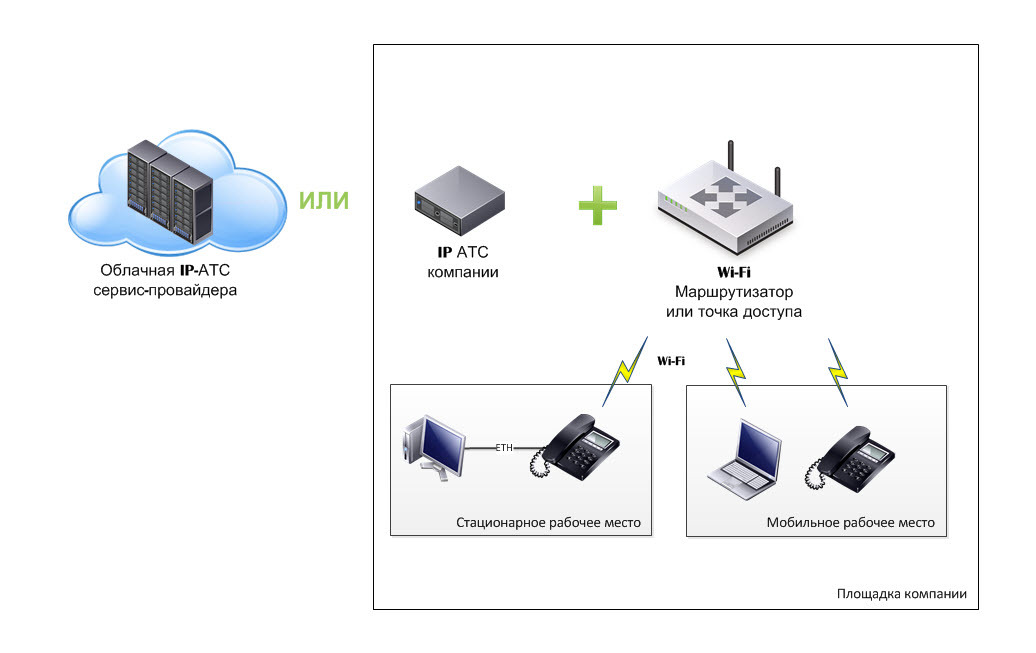
The scenario of using a landline Wi-Fi IP-phone
Stationary workplace - in this place the computer (desktop or laptop) does not have a wireless interface (Wi-Fi adapter), then the Ethernet network cable connects to the computer, on the other hand, the PC port of the wireless IP phone, then the phone connects via Wi-Fi to router or access point.
Mobile workplace - all devices in this place have wireless interfaces: a computer (desktop or laptop) and a wireless IP phone are connected via Wi-Fi to a router or access point.
As an IP PBX can be used
Phone Escene WS290 has an attractive appearance and a wide range of additional functions, while the product keeps an affordable price. When developing the phones, the engineers of Escence's engineers and designers used a unified approach to design, functional characteristics, and also control interfaces. The line includes models with different specifics: corporate wired models, models with Gigabit Ethernet, fixed Wi-Fi phones, universal models and phones for work in call-centers. But all models combine similar features - they meet high requirements and have all the necessary functions of corporate-grade IP phones.
The Escene WS290 phone is targeted at corporate consumers who place high demands on the appearance of the phones, on the quality of workmanship and usability while maintaining a reasonable cost.
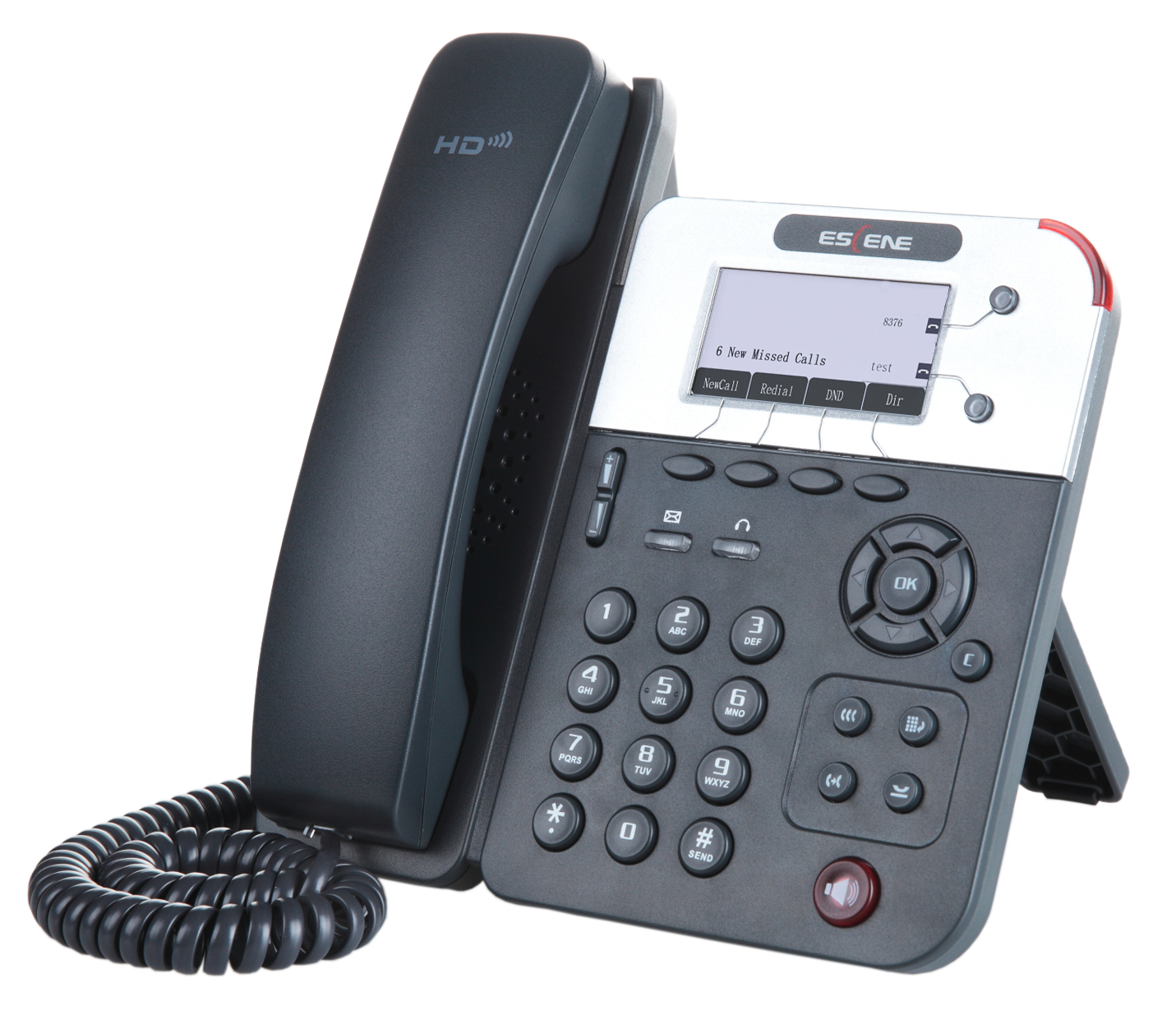
Positive features
Functionality
Specifications
VoIP
Data transfer
Physical parameters
Additional services (additional features)
Control
Nutrition
An adapter model Escene AD200 (AV 220/110 Volt, output DC voltage 5 Volt / 1A) is included in the package. PoE is not supported for this model.
Package, appearance and packaging
Packaging
The phone is delivered in a cardboard box that shows the company logo, on the side of the package there is a sticker with the model number, revision and barcode of the device.
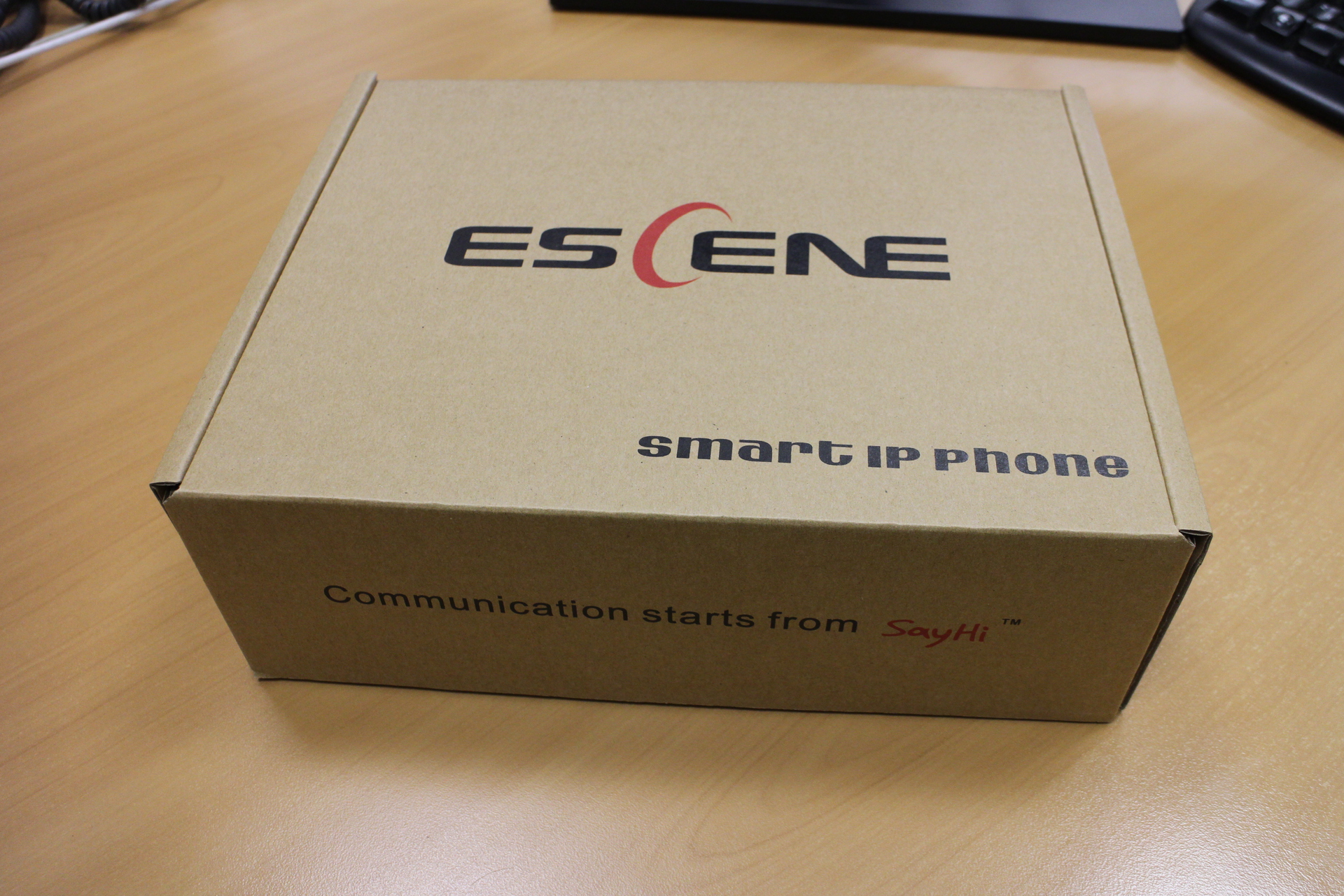
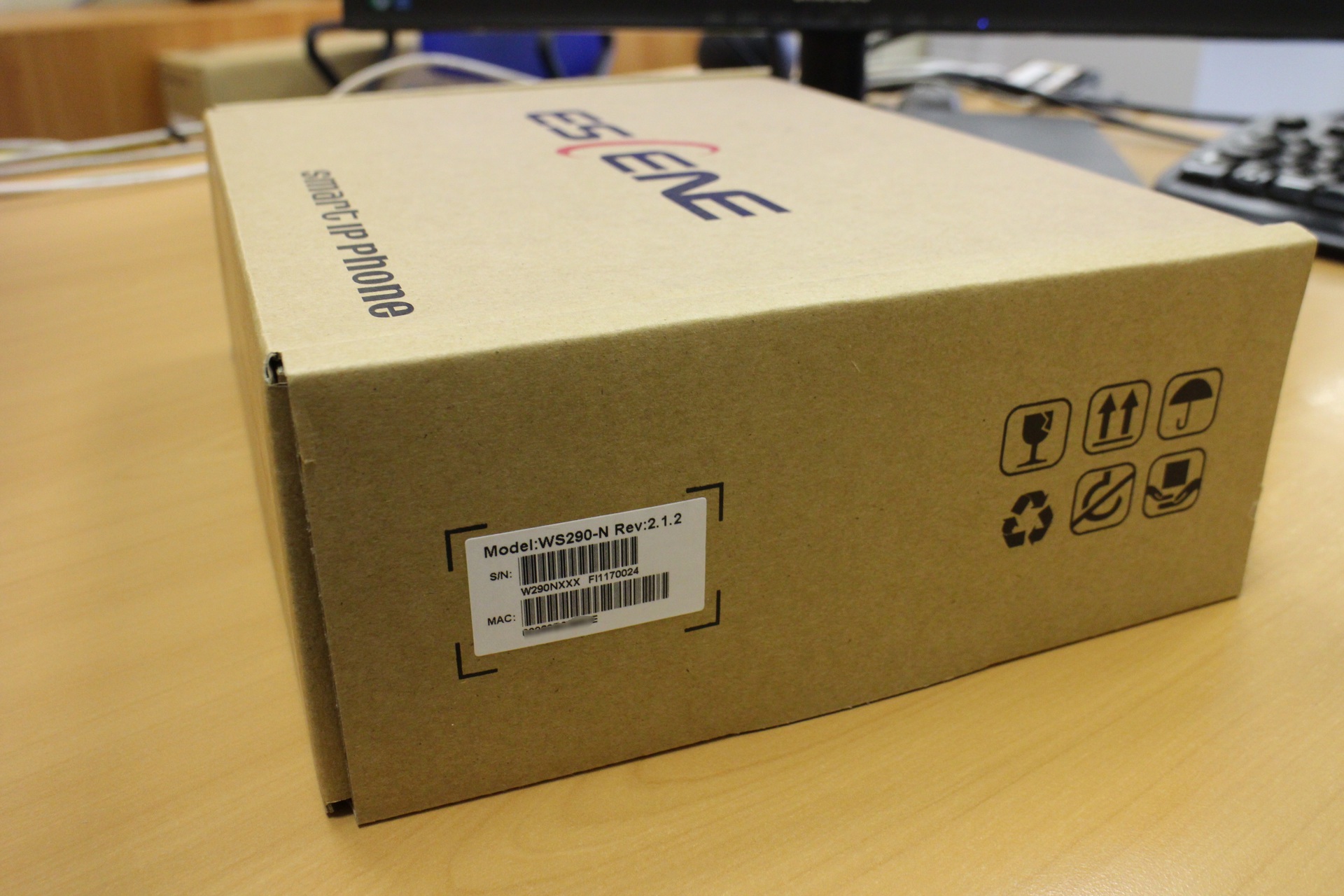
Phone kit
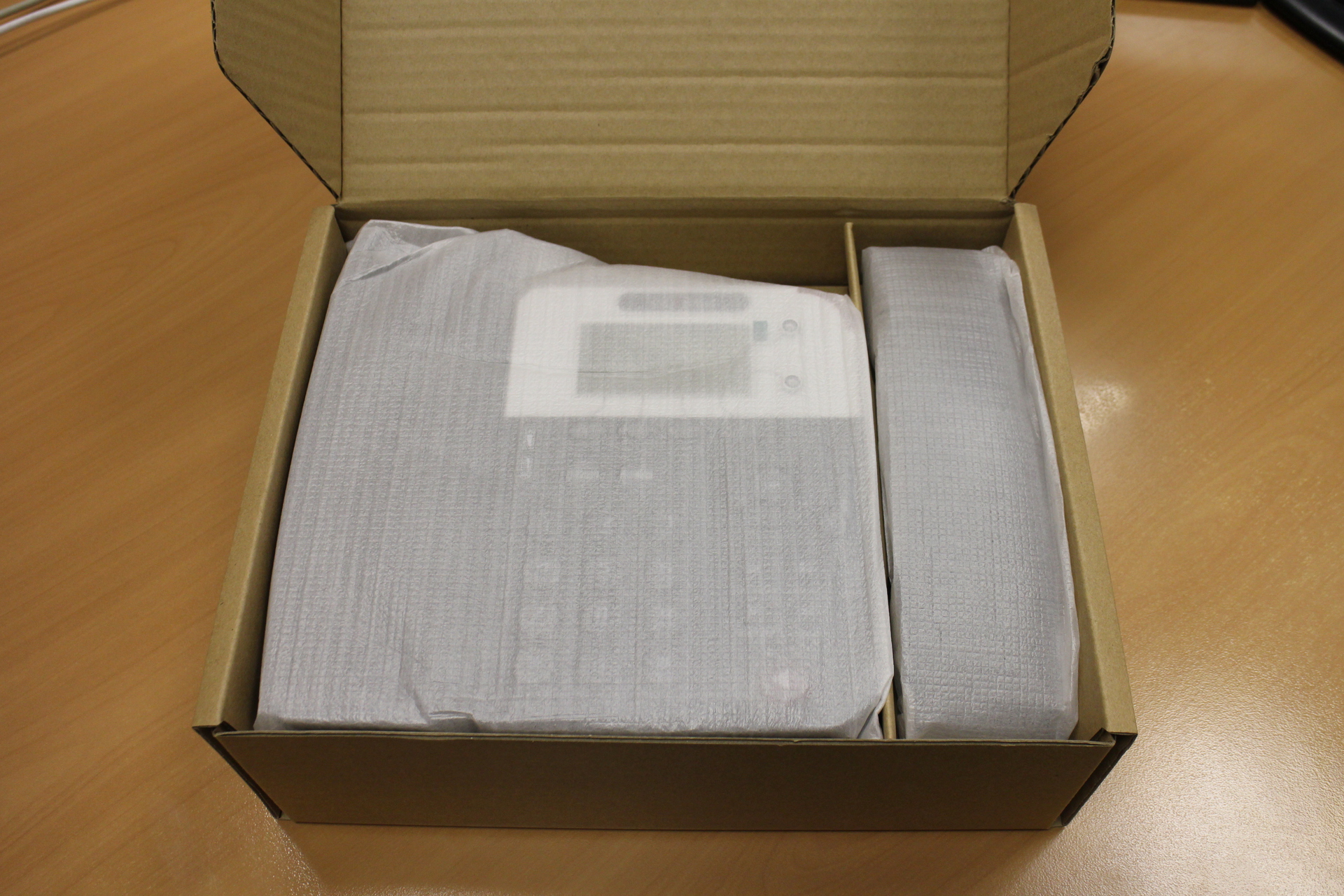

Inside the phone is neatly packed, there is nothing superfluous in the box, obviously, this equipment reduces the cost of the phone.
The box contains standard equipment, which includes

Conventionally, the buttons on the phone can be divided into 4 blocks
The first block is the management of phone service functions.
To the left of this block, there are two buttons for adjusting the phone / ring volume.
The second block is the management of additional functions.
Here are all the necessary buttons that are used most often:
Below this block is the mute button, if the microphone is turned off, the button is lit in red.
The third block - line management and multifunctional screen buttons
The phone has two independent SIP accounts (two SIP lines). By default, outgoing calls are established from line 1, if it is configured, if necessary to make a call from line 2, you need to click on the line button, then dial the number — the phone will send the call through the second SIP account.
The phone can accept two simultaneous calls. The “Line 1” and “Line 2” buttons are the light indication, when a call arrives, the diode of the line to which the call is being received flashes. If the line is busy, the line button is lit in red; if it is flashing, an incoming call has arrived. If the line is green, an active call is on the line; if it is flashing, the call is held on the line.
Each of the multifunctional buttons displays the currently active function, for example, “New call”, “End call”, “Do not disturb”, “Call transfer” and others.
The fourth block - multifunctional navigation keys
The block is used primarily for easy navigation through the menu, the “C” button is used to delete a character. Using the Up and Down buttons, you can adjust the ring volume or the volume of the phone during a call.
The panel has a separate large red button - “Hands-free”, which allows you to turn on or off the speakerphone (speakerphone), it is full-duplex in the phone. When the speakerphone is working, a red indicator lights up on the button.
Back of phone
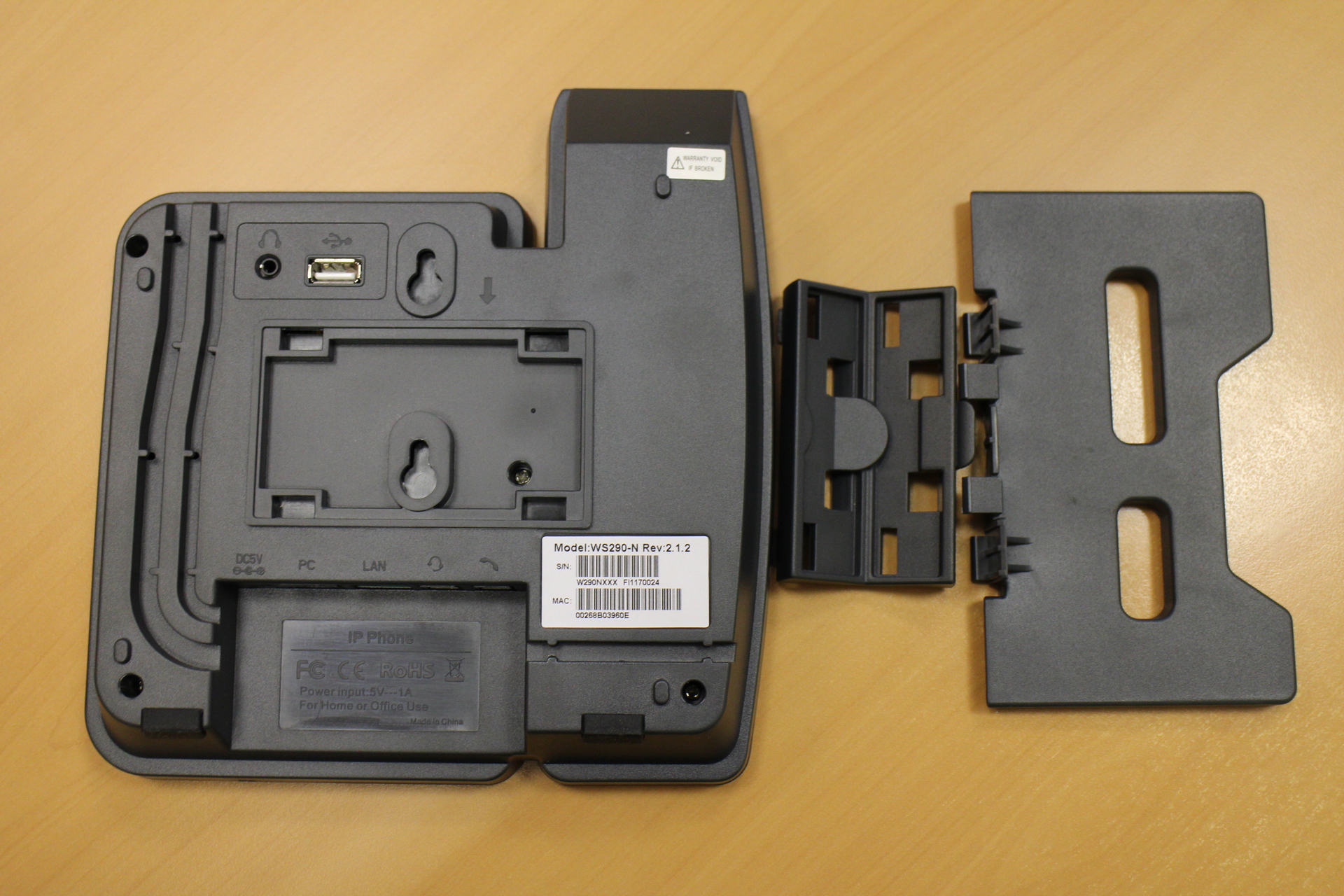
On the back of the phone is a standard sticker with the model number, serial number and MAC address. If for convenience you need to bring the handset or headset wires to the top of the phone, you can put them on the phone body, for this, there are two grooves on the panel. The device can be hung up on a wall or be established on a table. To hang the phone on the wall, it is necessary to remove from it the holder “Part 1” which closes one of the mounting holes.
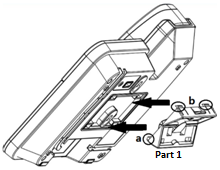
The design for installation on the table consists of two parts. To install the phone on the table, you need to attach the holder of the “Part 1” stand to the back panel, and then attach the “Part 2” stand itself to it, which are supplied in the kit. The stand can be installed at two angles, as shown in the figure below.
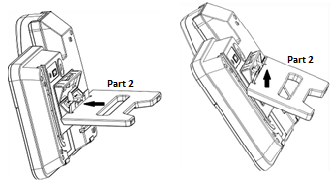
Phone Interfaces & Connectors
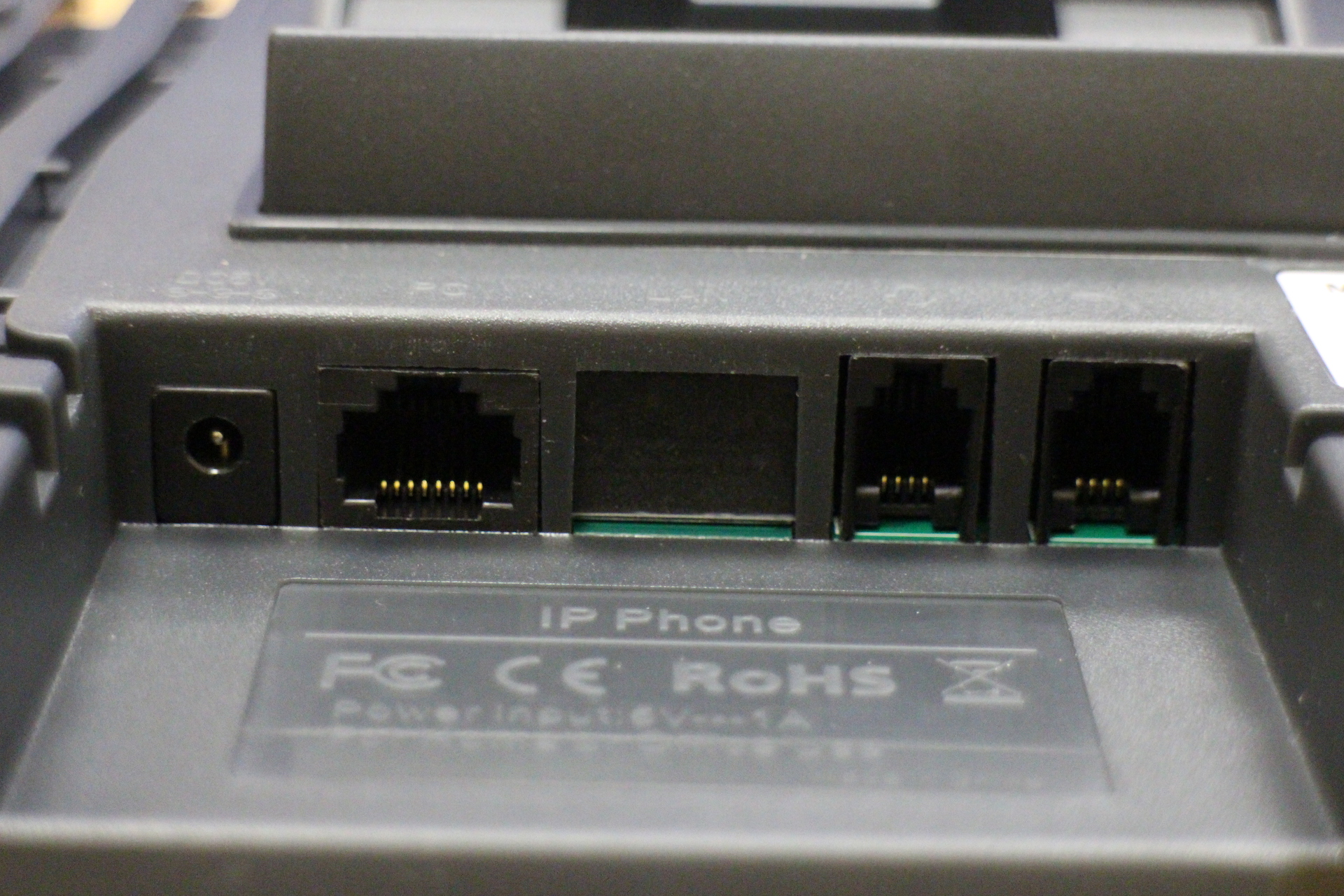
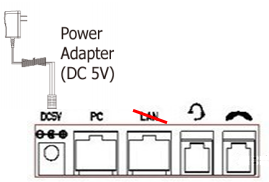
The photo shows a block of interfaces. For AC power using a power adapter, there is a 5 volt socket on the panel. The Ethernet interface is a PC for connecting the phone to a computer, there is a stub on the LAN port (and the image shows a strikethrough), since the LAN port is connected wirelessly. Two connectors for connecting the tube and headset with an RJ9 jack.
On the back there are jack jack 3.5 mm and USB.

Jack 3.5 mm are used to connect the headset. This is extremely convenient, since many headsets have such a connector.
The USB connector is designed to power devices, such as charging a phone with a USB cable. To do this, you need a USB cable type AMAM, that is, "dad-dad." His image is shown in the figure below.
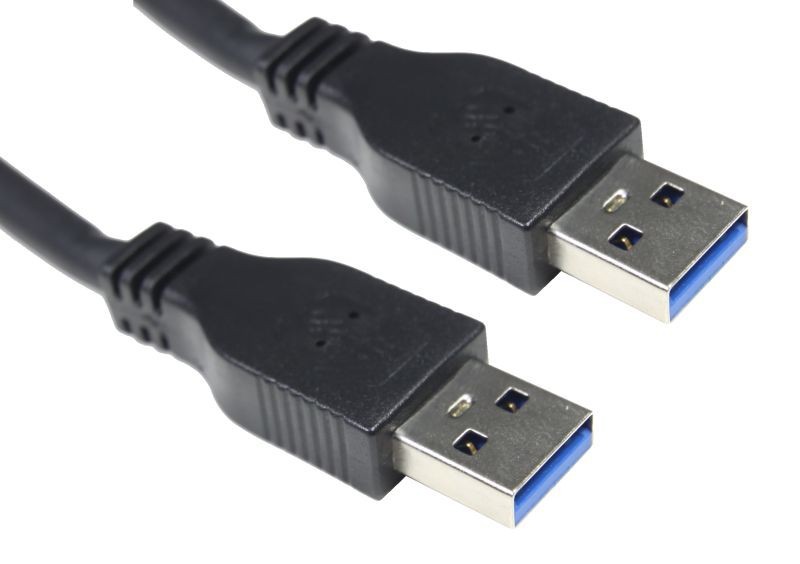
Here is the panel with the connected wires. The PC port connects to the computer.
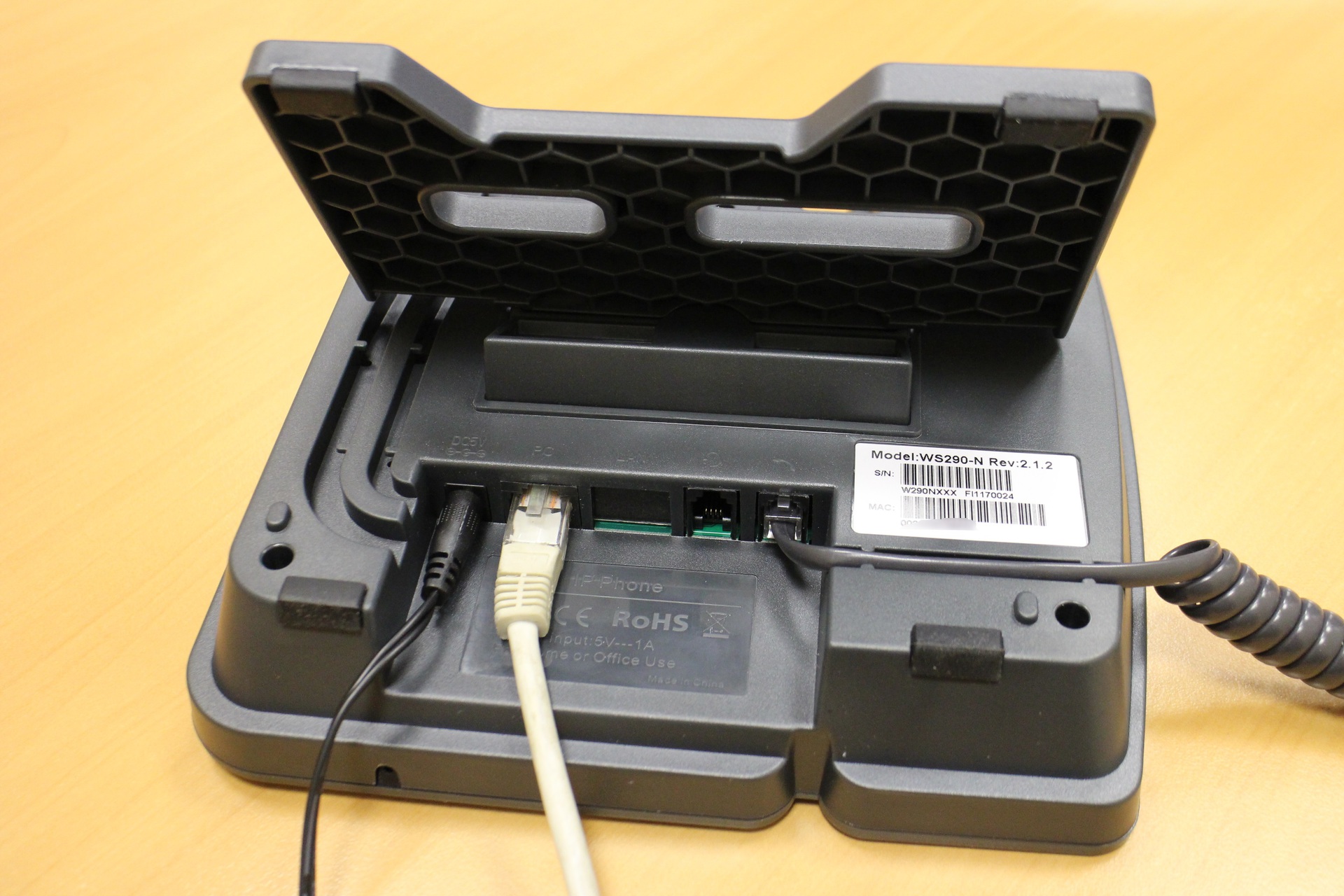
Wires do not interfere, the phone is exactly on the table.
View of the phone on the table
So the phone looks assembled, high-quality plastic, the screen backlight is not very bright, but enough to read the messages on the screen without difficulty.

Phone screen
It is worth noting a nice screen with good resolution. The phone has a monochrome LCD screen with backlight size 128 * 64, not large, but its size is enough to easily read the information from the screen.
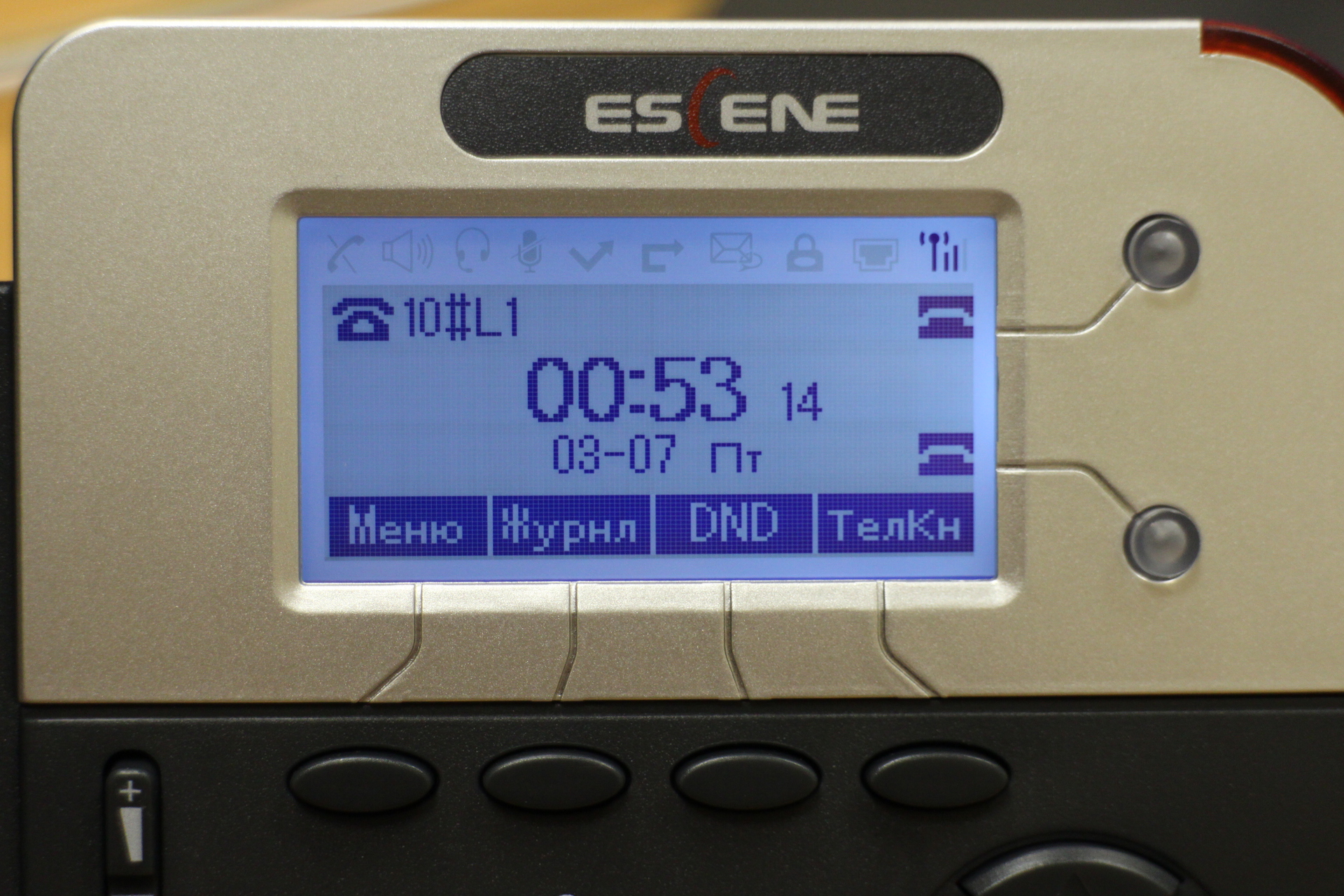
This is how the phone screen with the registered line in Russian looks. The inscription "10 # L1" on the buttons of the line is an arbitrary label that is configured in the "SIP Accounts" menu and is called "Label".
Enter and dial numbers. When you enter a number, the numbers on the screen are large and readable. When dialing a number, the button of the line through which the number is dialed lights up in red.
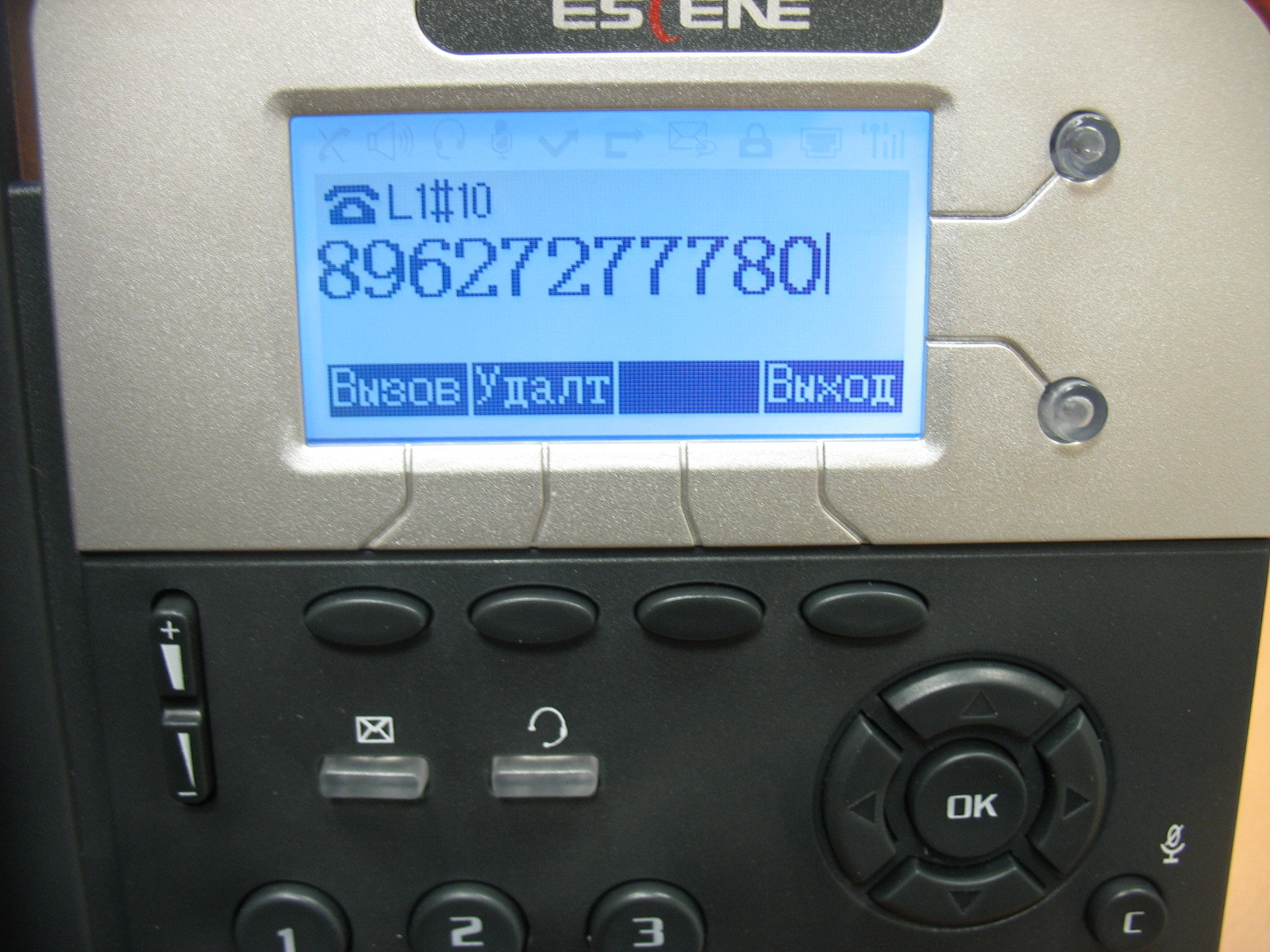

Incoming call.
In addition to the beep and on-screen indications, when an incoming call is in progress, the button of the line to which the call has arrived flashes.
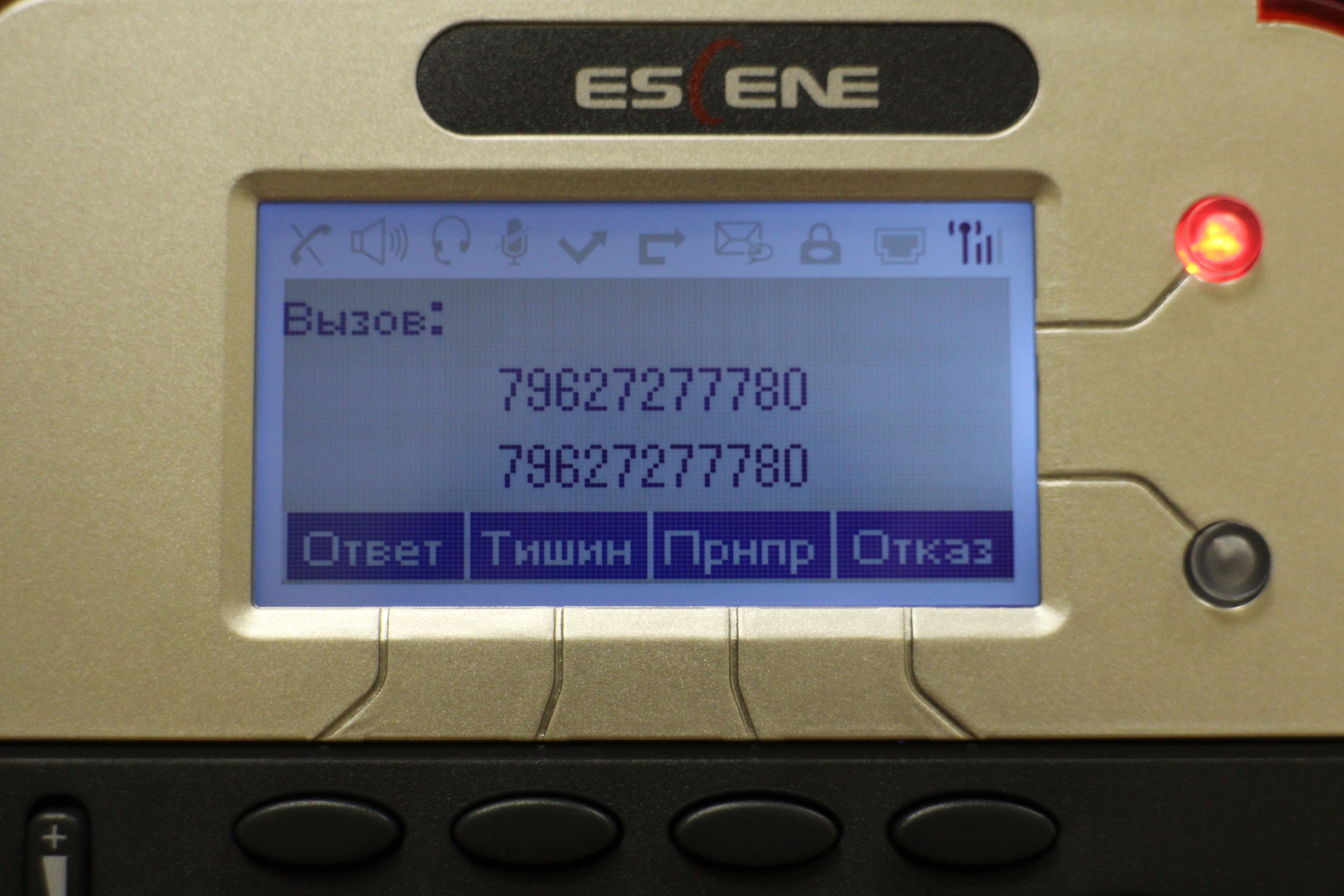
State of conversation. During a call, the line button is green.
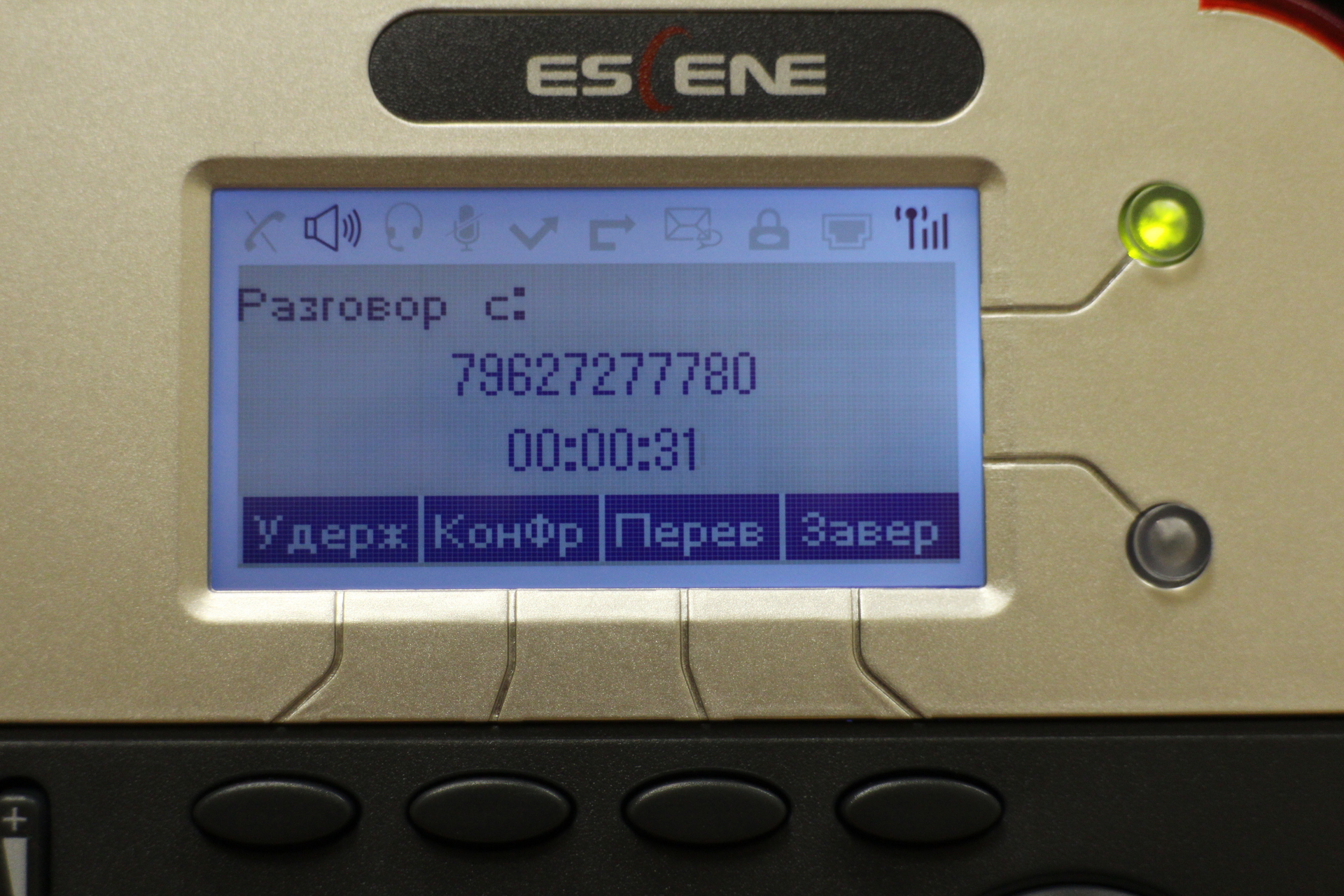
Call Logs
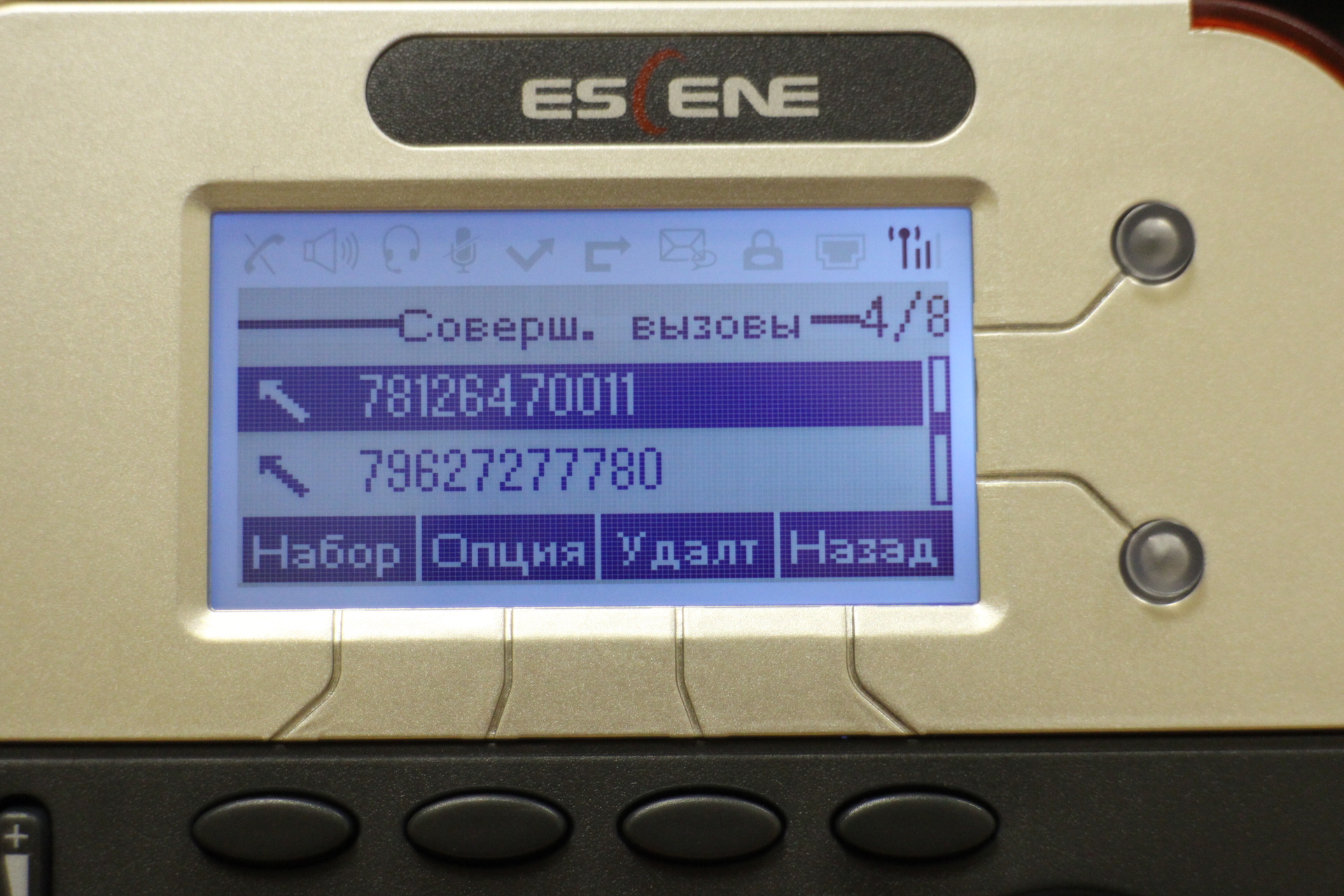
View of the menu on the phone screen

Phone setup
The phone can be configured either using the on-screen menu or using the web-based interface. Unlike most phones from other manufacturers, which leave a minimum of settings in the phone menu and a larger number only through the web interface, the Escene developers decided to make available from the phone menu in addition to the standard settings, settings related to SIP accounts.
Such a move is fully justified, in some cases, you can configure the phone faster. In addition, sometimes there may be problems with access to the phone through a web-interface or it may be necessary to explain to an employee remotely how to reconfigure his phone. It will be easier for an unprepared person to use the phone menu, rather than a web interface.
You can connect to the phone in two ways.
Initial setup using phone buttons
So, we installed the phone, if necessary, connected a computer to it via the PC port. An access point or a Wi-Fi router to which the phone will be connected has access to a local area network (LAN).
Now we need to include the Russian language in the menu.
Press the "Menu" button or the "OK" button, it is located in the middle of the navigation button block, a menu will open. Use the “Up” or “Down” navigation buttons to navigate the menu, press the corresponding button on the phone’s dialer or softkey (for example, “Enter” or “Select”) to select a menu item, use the “C” button to return to the previous item .
Next, press the number 3 (or the “OK” button), which corresponds to the choice of the “System Settings” menu, then select “Phone Setting” (number 3), then “Language” (number 1), using the up or down buttons Down "select" Russian "and click" OK "
Then press the "C" button until you exit the menu.
Now you need to configure network settings
Click "Menu" (or "OK"), then select the menu "System Settings" (or press number 3), number 2 - "Advanced Settings", the default password is empty, just click "OK".
If you need to configure a VLAN (menu item 2 - “Network”, 3 - “VLAN”), go to the appropriate menu and configure its ID and priority. Next, select 2 - “Network”, then 2 - “IP settings”, by default, after loading the phone, a DHCP client is activated that tries to obtain an IP address, therefore there must be a DHCP server on the network where the IP phone is located.
If you need to configure a static IP address in menu item 2 - “IP settings”, select “Static”; the menu for manually setting the IP address, mask, gateway and other settings will open. By default, the “Static” mode on your phone is configured with an IP of 192.168.0.200. Use the menu buttons and navigation keys to change these settings, after completion, click the Save button and the phone will reboot.
Now it's time to set up a wireless LAN connection.
The LAN port on the phone remained (comparing wired models of devices), but instead of an RJ-45 jack for connecting the cable, a plug was inserted, and the LAN port was connected to the Wi-Fi controller, the physical medium for transmission in this case is not the cable, but the wireless network , therefore, it must be configured.
To configure the wireless network, click “OK”, then select the “System Settings” menu (or press the number 3), the number 2 - “Advanced settings”, the default password is empty, just click “OK”, then step 2 - “Network” and Finally 1 - “Wi-Fi settings”. Being in this menu, first make sure that 1 - “WiFi: Enabled”, then select item 2 - “List of Wi-Fi networks” and click “OK” in response to the question “Start searching for WiFi networks”. The phone will scan the broadcast, and the list will display a list of all available SSID wireless networks, indicating the signal strength of the network. The higher the signal, the closer the wireless point is and the more confident the reception will be. Select the name of the wireless network to which you want to connect and click “OK”, the connection will be made if the network is not protected, or you are prompted to enter a password (network key) if it is set for this wireless network. Enter the password using the keyboard, for example, the letter b will correspond to 4 clicks on the "2" button on the telephone panel. After you finish entering the key, click the “OK” button, the message “Setting Wifi, please wait ...” will appear on the screen.
To make sure that the connection is successful, select menu item 3 - “Current network: NETWORK NAME” and click “OK”, in item 2 - “Status” the status is “Connected” - the connection to this network was successfully established or “Disconnected” - connection to this network is not established.
If the SSID of the network to which you want to connect is not announced on the air, select the “Enter SSID manually” option, then in the appeared menu, specify the SSID manually in the “SSID:” menu item and the encryption type in the “Encryption type” menu item (WPA / WPA2 / WEP ), network key, if necessary, then, to connect to the network, select the "Save" menu item to connect to this network with the specified settings.
Separate attention deserves the setting of "PC port"
(Menu -> System Settings -> Advanced Settings -> Network -> PC Port). Here you can configure the network operation mode between PC and LAN ports (working via Wi-Fi). In the “Bridge” mode, this is a two port switch. If you set the “Router” mode, the PC port is assigned an IP and a mask, the NAT address translation is enabled between the LAN and the PC, you can also enable the DHCP server. Thus, the phone also becomes a router with support for targeted NAT translation.
Now you need to check the correctness of the network settings and see the IP address that was assigned by DHCP, to do this, click "OK", select "Status", then number 7 - "View status", then "Network" menu, in my case IP address, assigned by DHCP: 192.168.1.27.
Another interesting setting worth mentioning is the AP (Access Point) mode, which allows you to turn an Escene WS290 into an IP phone with a wireless router. It is very easy to configure: you need to enable AP mode (Menu -> System Settings -> Advanced Settings -> Network -> Wifi Settings -> AP) check the network name, configure security (encryption type, network key), enable the DHCP server and set the IP pool addresses from which the phone will distribute to wireless clients. The PC port must be connected to the local network. Do not forget to restart the phone. After the reboot, the wireless client’s Wi-Fi function will turn off and the wireless router mode will turn on, and the phone’s SIP lines will be registered and can be used as usual. In certain cases, this function may be useful.
Setting up additional phone features
All these settings are made in the “Menu” -> “Functions” (number 2)
Support for additional services (DVO) and programmable buttons
The phone supports two independent SIP accounts, that is, registration on two different IP PBXs. At simultaneous registration of both lines, by default, the first line will be used. To switch to the second line (it should be configured) and return to the first one, use the “Line 1” and “Line 2” buttons.
I note that the phone supports two simultaneous calls, so to use simultaneous SIP registration on both lines in the SIP account settings for each line, you must set the "Number of lines used by the account" parameter to 1 (default value is 2). That is, the device supports only two lines, you can distribute them at your discretion: either assign both lines to the first SIP account, or distribute one line to each SIP account and register both at the same time.
As for the DVO - they all work correctly
To access call logs
Phone web interface
To access the web interface from a computer that has access to the network where the phone is located, enter the IP address of the phone in the address bar of the web browser, in my case it is 192.168.1.35.
Default login and password:
root
root
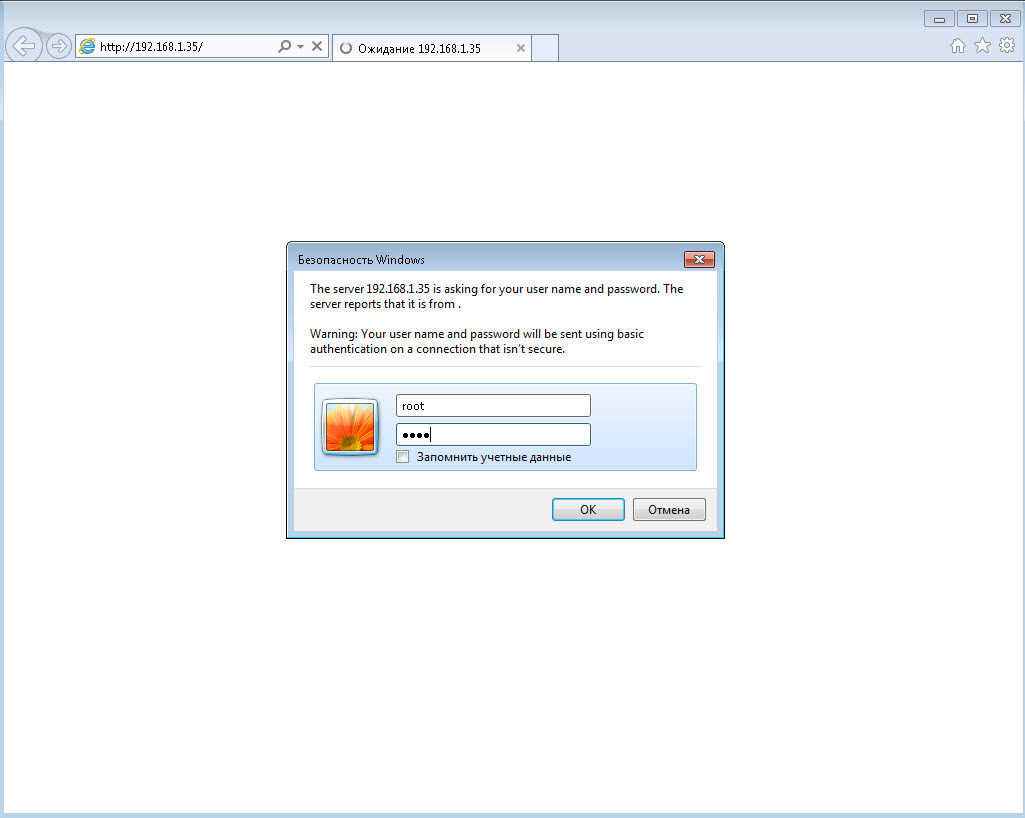
We get to the main menu of the web configurator of the phone. For convenience of setting, we immediately select the Russian language in the bottom left menu.
The menu is divided into several groups.
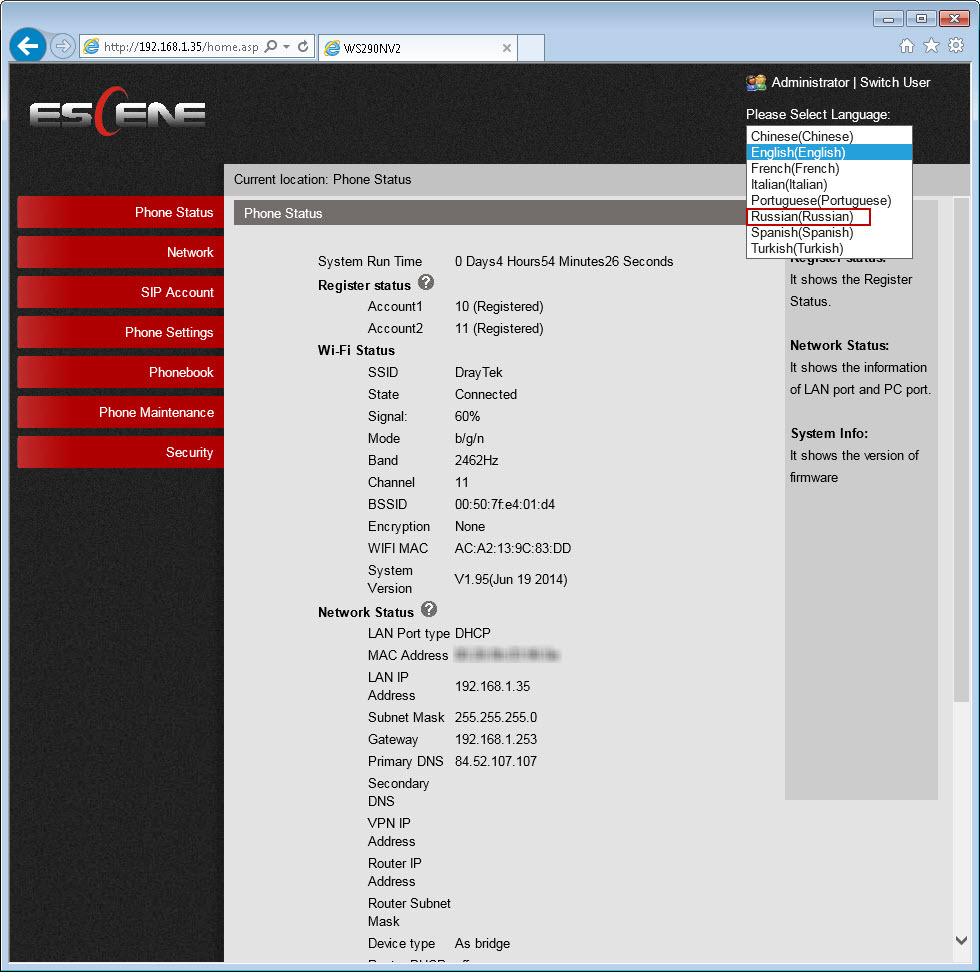
Menu "Phone Status"
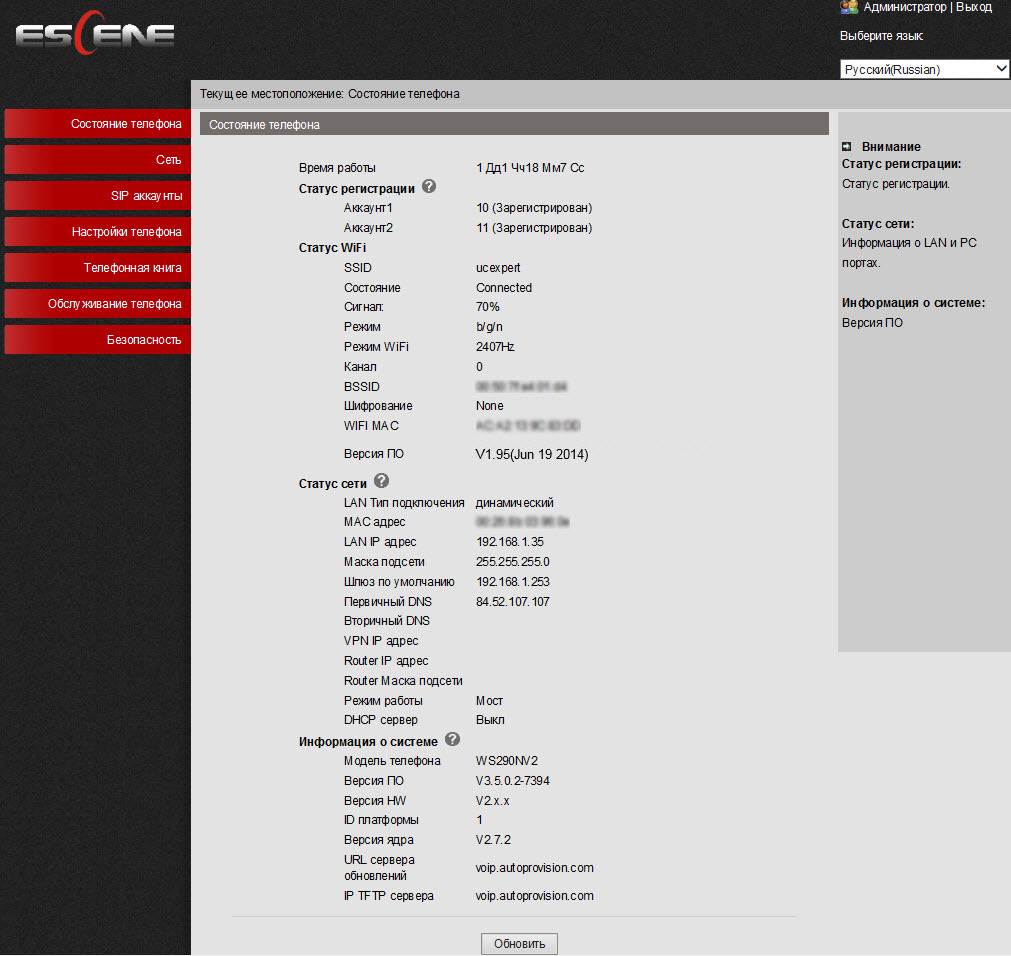
The menu refers to the service settings, allows you to get detailed information about the status of settings and statistics of the phone, such as time in operation, the status and health of the network connection, the status of the registration of SIP-lines, the firmware version and others.
In the “Wi-Fi” Status section you can find detailed information on connecting to a wireless Wi-Fi network, including the signal level and the signal level of the selected network. For example, in the image, the phone is connected to the ucexpert network with a signal level of 70%.
Network menu
Network menu -> W-Fi settings menu
This menu is used to configure the phone’s connection to a Wi-Fi network.
Here you can turn off the wireless Wi-Fi module, scan the air for wireless networks, then select the desired network or specify its name manually, specify the encryption type and network key, as well as view the connection status.
Menu "Network" -> "LAN port"
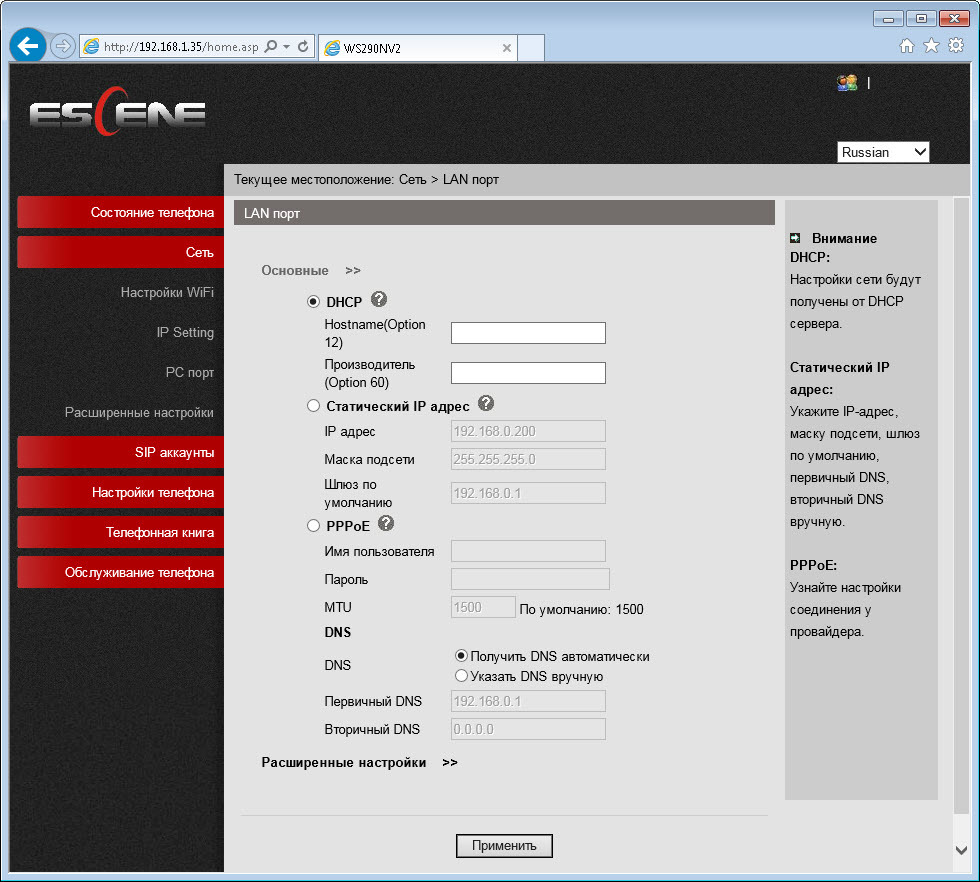
Basic Settings Tab
You can set one of three connection methods: DHCP, static IP, or PPPoE.
Advanced Settings Tab
Also important setting is HTTP and Telnet ports. They should be made non-standard if the phone is on an untrusted network (for example, with an external IP address on the Internet).
Also here you can configure Paging - group notification.
Menu "Network" -> "PC port"
L2 switching is switched on by default between the LAN and PC ports of the telephone - the “Bridge” mode. The phone can switch to L3 routing mode — a NAT address translation will start on the LAN port, an IP address will need to be configured on the PC port, and if necessary, a DHCP server must be enabled in which to set the pool of IP addresses for clients.
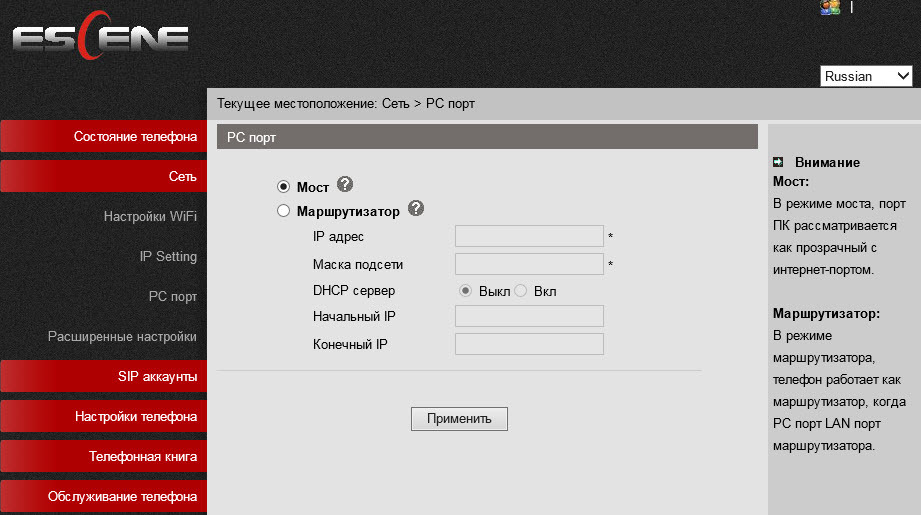
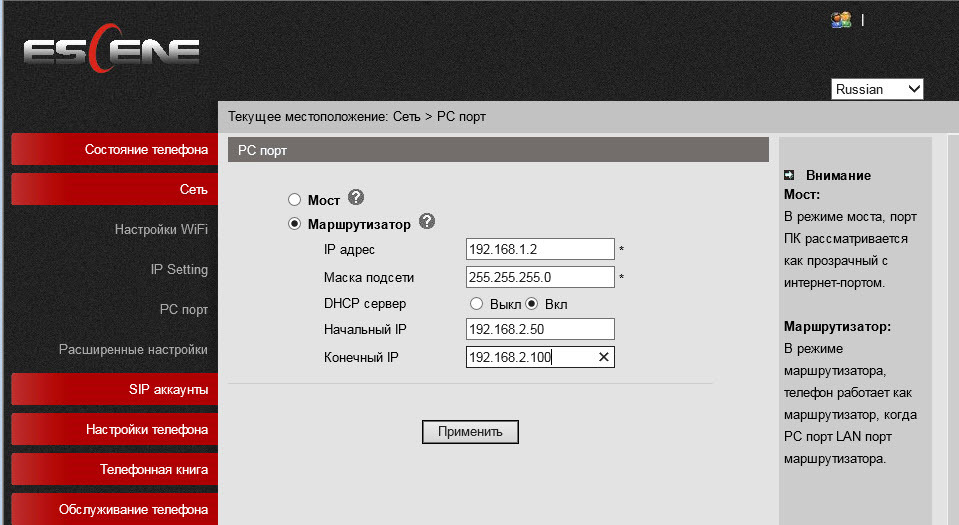
Menu "Network" -> "Advanced Settings"
VPN Settings tab

If you need to connect your phone via a secure VPN channel, this can be done directly from the phone, without buying additional equipment (for example, a VPN router), the phone supports L2TP and OpenVPN (SSL VPN). This is a very useful feature for several reasons.
Firstly, if you have several phones that need to be delivered to a remote office, there is no need to buy a VPN hub at each remote location, you just need to configure the VPN client built into the phone. Further, through the tunnel to register his phone on the IP PBX in the central office.
Secondly, VPN improves security, more and more administrators are thinking about how to protect terminals that are on the Internet, two problems are becoming more acute: the danger of hacking the terminal and the difficulty of accessing telecoms operators to configure it, because often the terminal is behind NAT. Using a VPN client solves both of these problems, so this useful feature will become increasingly popular. In the example, using the VPN type L2TP, a connection to the vpn.ucexpert.ru server was created.
VLAN Settings Tab
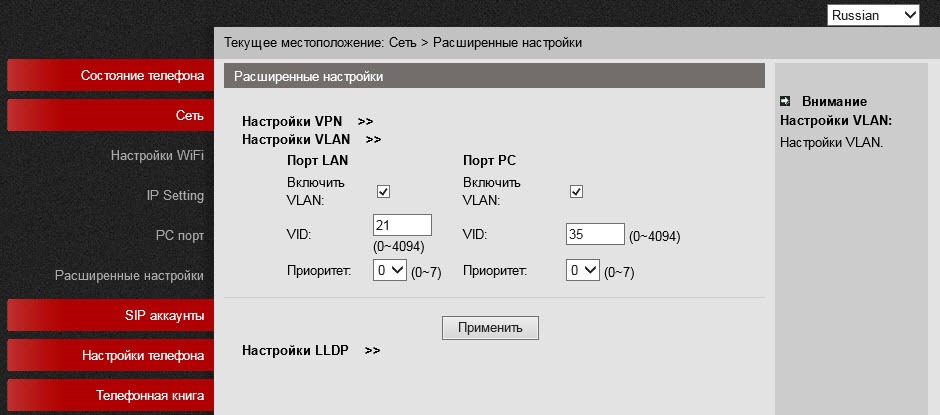
In a corporate network, it is recommended to isolate the computer network traffic from the voice network traffic, this is most often implemented using two VLANs. The phone supports VLAN on both ports.
Menu "SIP accounts"
The phone allows you to manage a large number of SIP signaling settings and settings for RTP media traffic.
Menu "SIP accounts" -> "Account 1"
Tab "Basic"
In addition to the standard SIP account settings - User Name (UserID), Name (AuthID) and password, there is a “Label” field, it allows you to insert an arbitrary line description that will be displayed on the phone screen.
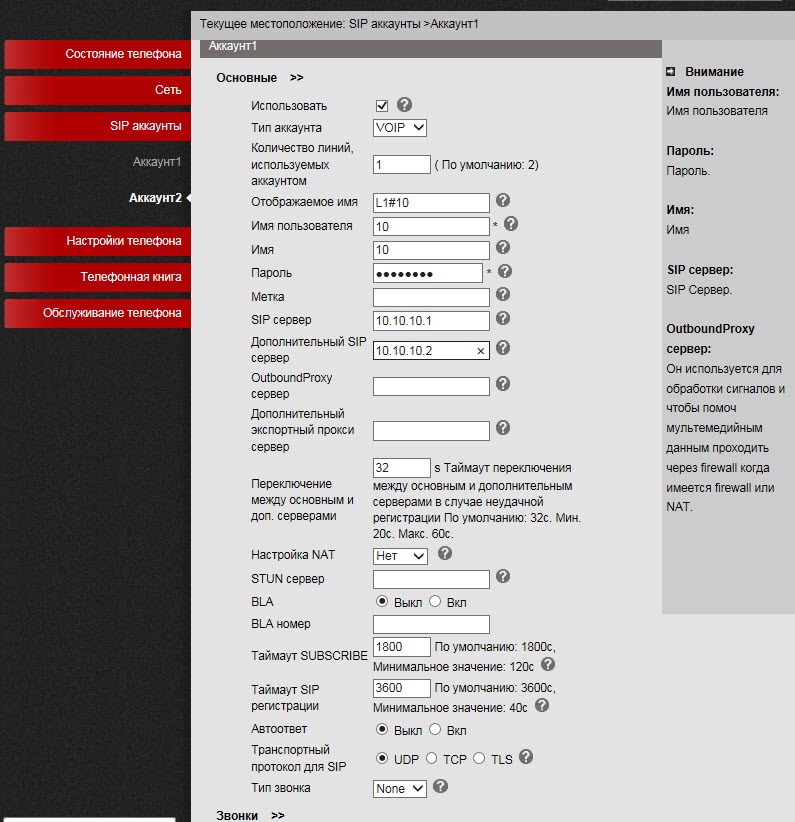
In addition to the primary IP address of the SIP server, you can add an additional IP SIP server. In case of unsuccessful registration during the timeout, which by default is 32 seconds, the address of the additional SIP server will be used for registration. The setting “Number of lines used by the account” should be equal to 1 if you need to use both lines, because the second line must be assigned to the second account.
If you leave the value equal to 2, then when applying the settings of the second line, the phone will display a message that there are not enough lines.
Calls tab
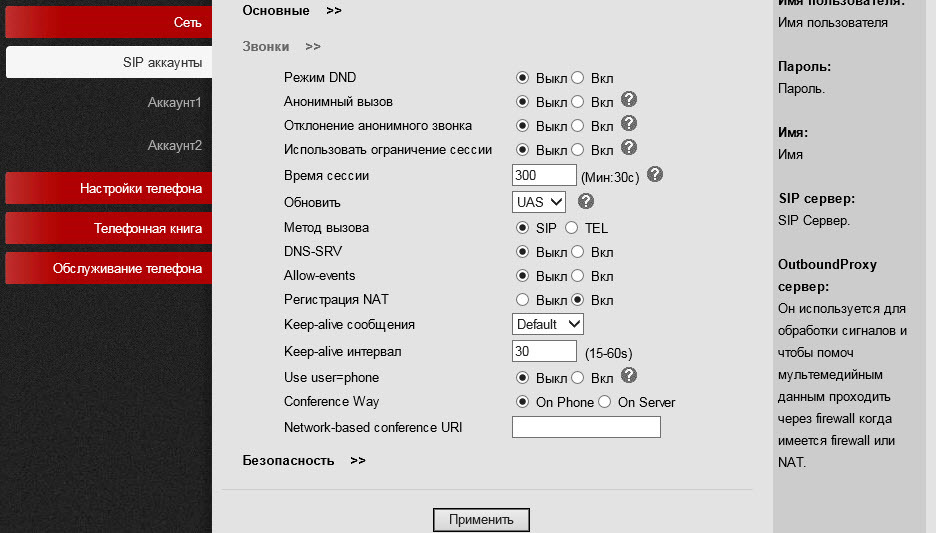
Here you can specify additional settings to overcome NAT, enable DNS SRV.
Security tab

The phone supports encryption of RTP and SIP signaling traffic using TLS protocol.
Phone Settings menu
Menu "Phone Settings" -> "Basic"
Here you can configure various functions of the phone, such as the “Hotline” - when you pick up the handset, the preset number is automatically dialed, you can turn on auto-search in the address book during dialing and auto answer the call.
The important setting is DTMF type - by default it is set to RFC2833.
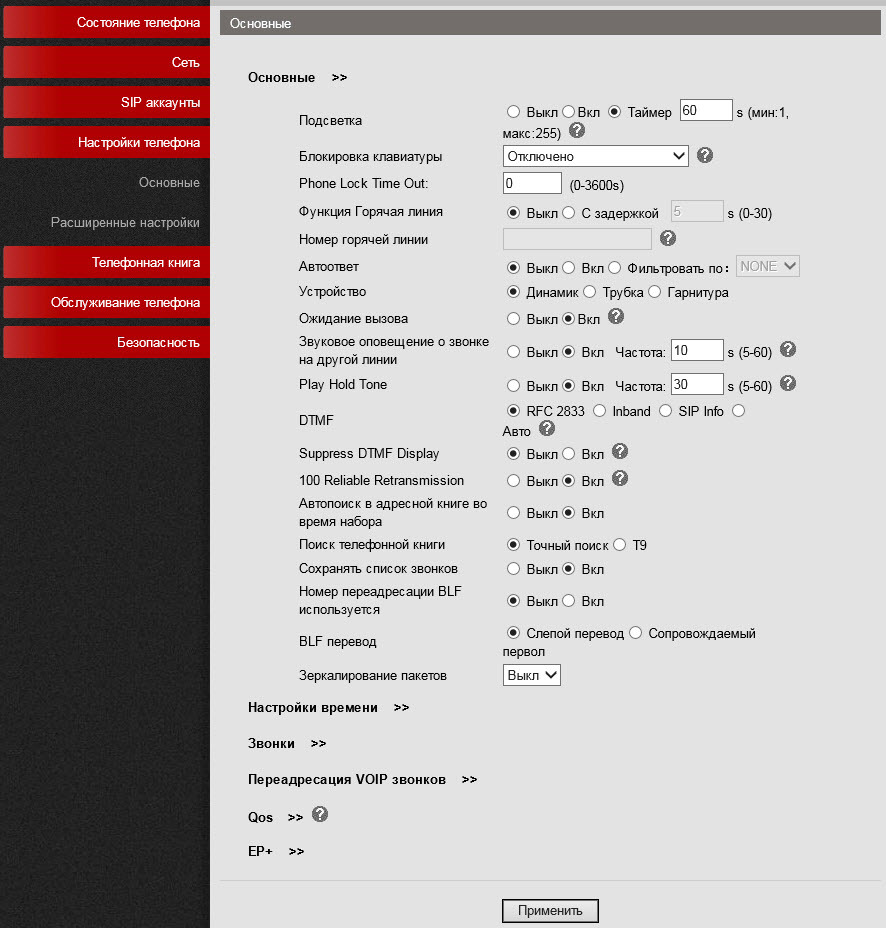
Calls tab
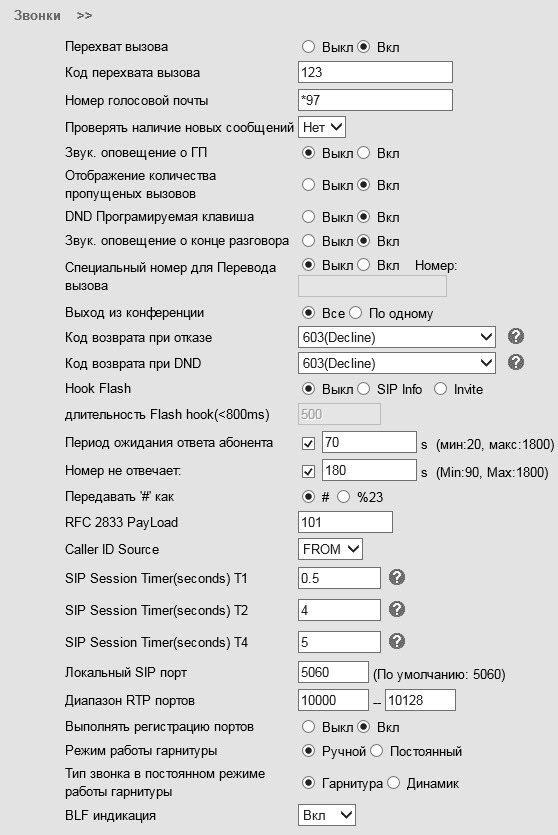
In this menu, global functions for the phone are configured.
If you set up the SIP settings here, they will be applied to both lines automatically, except for the settings “Local SIP port” and “RTP port range”, which can be useful for properly configuring the firewall.
In case the call transfer is required to be performed with a special key combination (old code), instead of the standard SIP message 302, this can be specified in the setting “Special code for call transfer”. A useful setting that allows you not to break the connection in the conference, if it left the initiator. You can set call forwarding by condition (busy and “no answer”) and unconditional.
Here you can also set codes that will be transmitted when you press the “Pickup” buttons (the value in the “Call Pickup Code” field) and “Voice Mail” (the value in the “Voice Mail Number” field).
There are three ways to intercept a call.
The important setting is “Return Code on Failure” and “Return Code at DND”, by default IP PBX returns SIP message 603 Decline, these messages can be changed to others, if necessary for correct interpretation of the reason for the release.
Tab "Forwarding VOIP calls"
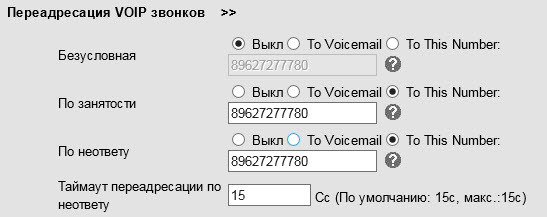
The tab is set forwarding: unconditional, if the subscriber did not answer or the line is busy.
Menu "Phone Settings" -> "Advanced Settings"
“Sound - Basic” and “Sound - Extended” tabs
Here you can set the volume of the telephone, speaker and ringing tone. Also, the volume settings of the microphone tube and speakerphone. By default, when calling, the phone claims all possible codecs. If necessary, unused codecs can be disabled. Here you can enable echo cancellation and VAD. Moreover, you can download your own ringtone.
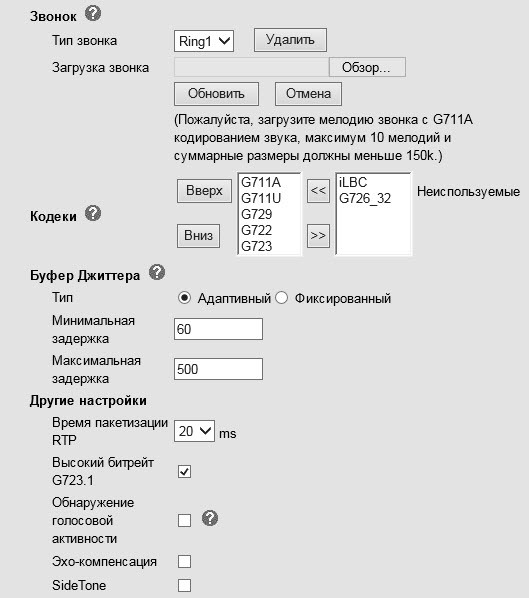
Line tab

The Account selection menu can take the values Account1 / Account2 / Any and becomes active if the button is assigned a dialing mode, for example, speed dial, DTMF or speed dial prefix.
Function Keys Tab
In this menu, you can assign an action to the function buttons of the phone if the actions they perform by default for some reason should be different. To do this, in the drop-down menu of the choice, specify the action that will be performed when you press the button.
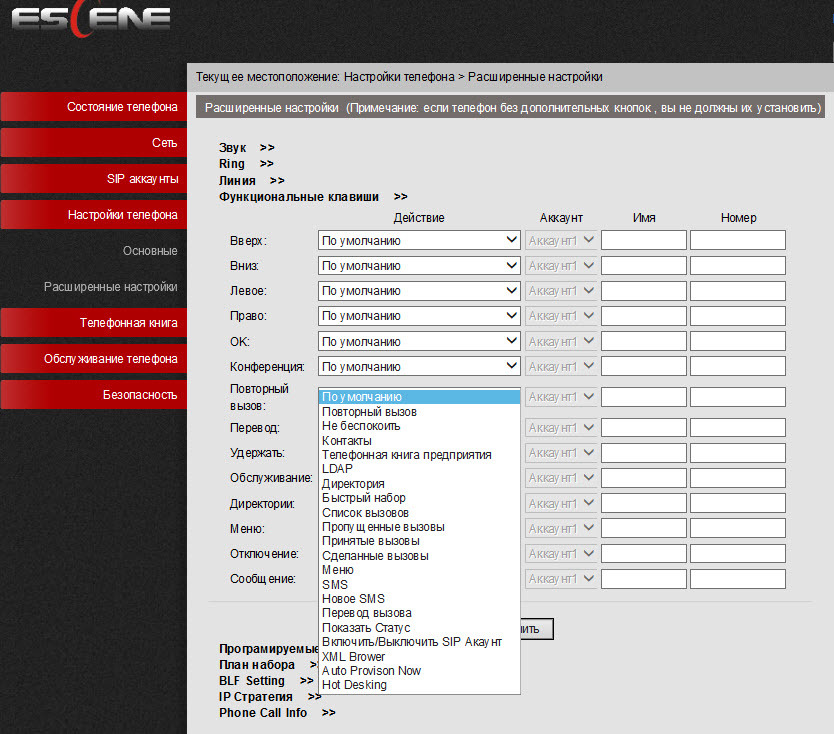
Tab "Soft Keys"
Allows you to manage the sets of soft buttons that appear on the phone screen depending on the state of the phone (handset is on, handset is off, connected, talking, etc.) This is a very useful feature that allows you to control the functions available to the user.
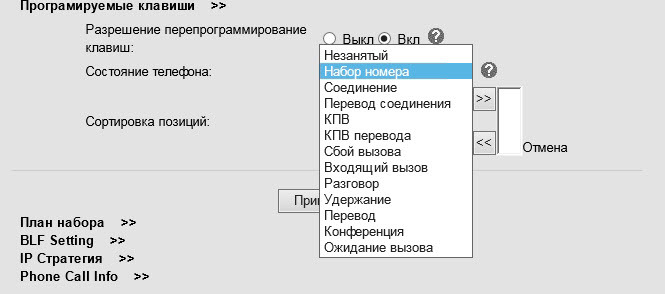
Menu "Phonebook"
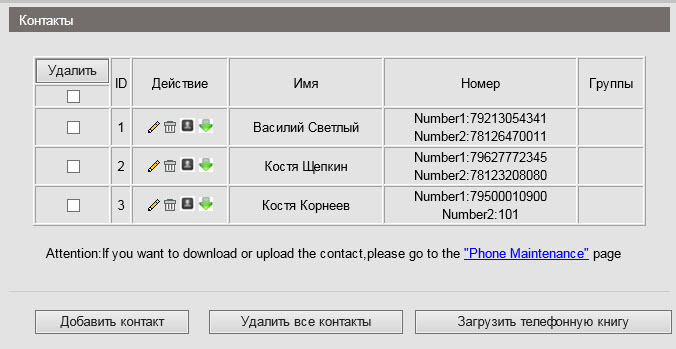
The phone has a built-in phone book, which is quite advanced. It allows you to store up to 300 contact entries, each of which can store up to 3 phone numbers. Entries can be made via the phone's on-screen menu using the web-based interface. To download or save an already-created phone book in XML format, use the Phone Service menu -> Update over HTTP -> XML Phone Book; here you can save or load the phone book in XML format.
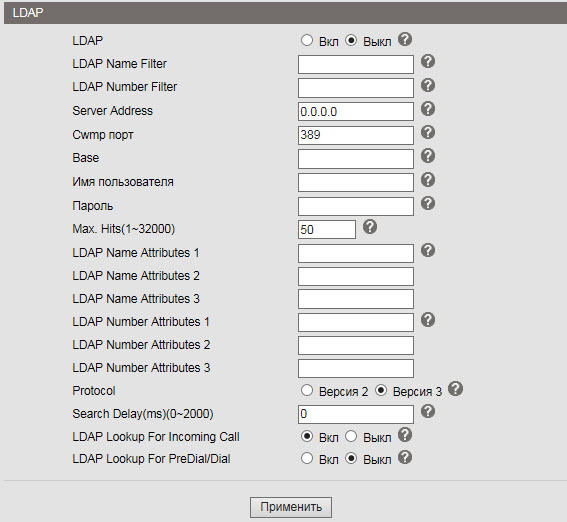
If your company uses an LDAP server, you can connect a phone to it and synchronize corporate contacts. 2 and 3 protocol versions are supported, as well as using the “LDAP Lookup For Incoming Call” and “LDAP Lookup For PreDial / Dial” settings, you can search for the contact name for an incoming and outgoing call. If the contact is in the LDAP directory, then its name will be automatically added to the number.
The phone also supports blacklists or ban lists: an unwanted phone number is added to such a list and can no longer reach you.
Menu "Phone service"
Menu "Phone service" -> "Basic"
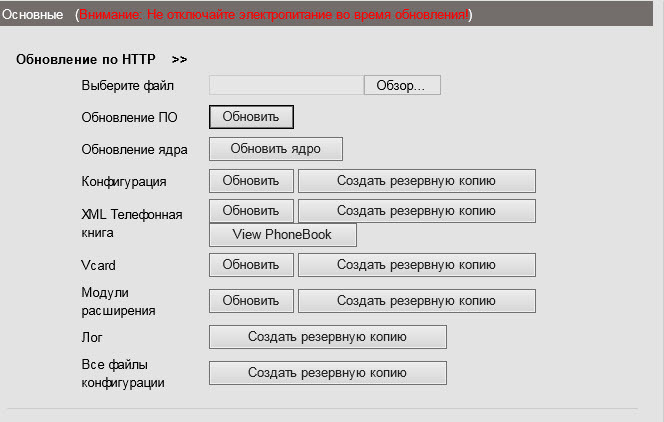
You can copy configuration files using three different protocols. FTP, TFTP and HTTP - the choice of a particular protocol is a matter of taste and convenience. Software update is extremely simple, you need to select the firmware file, then click update. If the version of the downloaded firmware of the phone is lower than the installed one, a window will appear with the inscription “Filename is illegal”. In the menu, you can also restart the phone or reset it to the factory settings.
Menu "Phone Settings" -> "Advanced Settings"
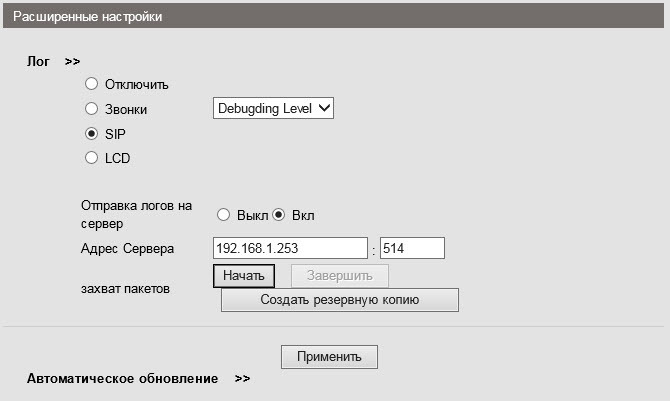
To debug the phone, you can enable logging by specifying the necessary logs. You can view them in two ways:
Also, the phone has the ability to collect network dump packages into pcap files, which can then be analyzed using a sniffer, for example, Wireshark, this is an extremely effective debugging tool.
To start capturing packets, click the “Start” button. When finished, click the “Finish” button. To download the received dump, click the "Create backup" button.
Also on the “Automatic Update” tab, you can configure the phone's firmware update according to the TFTP / FTP / HTTP / HTTPS protocols.
Security menu
Here you can set a username and password for the administrator and user of the phone, as well as download an SSL certificate.
Setting up the phone's SIP lines
Setting up connection to IP PBX Asterisk using web-interface
Suppose we need to configure two extensions (two SIP accounts). For example, the first entry on the IP PBX Asterisk, the second on the virtual IP PBX:
IP address of the server with Asterisk = 10.10.10.1
UserID = 10
password = QOXZuTcZ38qlBsr
SIP server (Asterisk) = 10.10.10.1
In the Asterisk sip.conf configuration, this will be equivalent to:
[ten]
deny = 0.0.0.0 / 0.0.0.0
secret = QOXZuTcZ38qlBsr
dtmfmode = rfc2833
canreinvite = no
context = from-internal
host = dynamic
type = friend
nat = yes
port = 5060
qualify = yes
callgroup = 01
pickupgroup = 01
allow = g722
dial = SIP / 10
mailbox = 10 @ device
permit = 0.0.0.0 / 0.0.0.0
callerid = device <10>
callcounter = yes
faxdetect = no
Equivalently, when configured in the Free-PBX web interface, using the first line as an example:


To work with Asterisk, it is enough to configure the Username (Username) = 10 , the password (Password) = QOXZuTcZ38qlBs r and the SIP Server (SIP Server) = 10.10.10.1. You can add a label (Label) that will be displayed on the screen of the phone, in this case "L1 # 10".
You can reduce the re-registration time from standard 3600 seconds to 600 seconds, this is especially true if the IP PBX is located outside the office, for example, Virtual PBX. If the phone is on a local network and the IP PBX is on the Internet, no special settings are usually required to overcome NAT. Next, click the "Apply" button.
Setting up a SIP line connection (SIP account) using a web interface
Exactly the same must be done with the second line, for example, the city number 78126470011 on the SIP server West Call.
We will register it on a virtual PBX with a non-standard SIP port 9966
userid = 78126470011
authid = 6470011
password = eIoMzKsf
sip proxy = uc.westcall.net
port = 9966
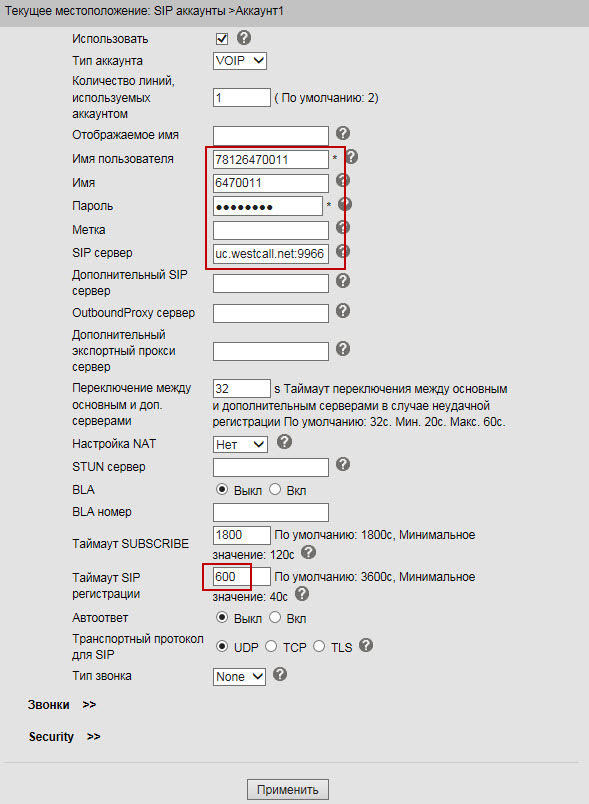
To specify a non-standard SIP port (other than 5060), you must explicitly specify it in the SIP server line: uc.westcall.net:9966 . Next, click the "Apply" button.
In case of successful registration, the corresponding display will appear on the phone screen, so information on the status of line registration is available on the Status menu page:
Account 1: Registered
Account 2: Registered
In order to use the DVO buttons (transfer, hold, conference) no additional configuration is required.
findings
Corporate IP-phone Escene WS290 is one of the most profitable offers on the market, taking into account its cost and functionality. In addition, the device has a stylish appearance, high quality plastic and good ergonomics. The device is easily configured, it works stably, does not lose registration, has good sound quality, additional functions (transfer, retention, redirection, etc.) also work stably.
The key features of the phone include
The Escene IP phone range , which has proven its reliability and simplicity by user experience and good reviews, has introduced a new Escene WS290-N phone. This phone is a wireless analog of the popular Escene ES290 model, but differs from it in some features characteristic of wireless Wi-Fi phones.
Connecting the phone to the network via Wi-Fi significantly increases the flexibility of the connection - increasing mobility and ease of telephony deployment. Using cordless phones to easily organize a workplace without wires, one can cite a lot of examples where connecting phones and workplaces over a wireless network is, if not the only way out, then a highly desirable option.
')
For example, the construction of a LAN is economically unjustified or a functioning local area network already exists. A good example is the need for high mobility and speed of network deployment to a working state. Also, the wireless connection of the workplace can be useful for aesthetic reasons, for example, a minimum of wires and objects in the workplace. When conducting time-limited activities, it is easier, faster and more convenient to deploy a wireless network. If employees often move from office to office, you can transport the “network with you” simply by using cordless phones.
Now there are wireless solutions on the market - VoIP-DECT phones, but they are less convenient to work in a stationary workplace, and are intended for employees who move most of the time, for example, within the enterprise.
Below is a diagram of the typical use of a landline Wi-Fi phone.

The scenario of using a landline Wi-Fi IP-phone
Stationary workplace - in this place the computer (desktop or laptop) does not have a wireless interface (Wi-Fi adapter), then the Ethernet network cable connects to the computer, on the other hand, the PC port of the wireless IP phone, then the phone connects via Wi-Fi to router or access point.
Mobile workplace - all devices in this place have wireless interfaces: a computer (desktop or laptop) and a wireless IP phone are connected via Wi-Fi to a router or access point.
As an IP PBX can be used
- Own PBX or service provided by the provider.
- IP PBX companies - software or hardware and software platform located in the company's office (for example, Asterisk, 3CX, etc.)
- Cloud IP PBX is a platform located at a service provider (for example, Westcall, Telphin, Mango, etc.).
Phone Escene WS290 has an attractive appearance and a wide range of additional functions, while the product keeps an affordable price. When developing the phones, the engineers of Escence's engineers and designers used a unified approach to design, functional characteristics, and also control interfaces. The line includes models with different specifics: corporate wired models, models with Gigabit Ethernet, fixed Wi-Fi phones, universal models and phones for work in call-centers. But all models combine similar features - they meet high requirements and have all the necessary functions of corporate-grade IP phones.
The Escene WS290 phone is targeted at corporate consumers who place high demands on the appearance of the phones, on the quality of workmanship and usability while maintaining a reasonable cost.

Positive features
- Part of a single corporate level lineup.
- Wireless Support Wi-Fi IEEE 802.11 b / g / n
- High quality body materials.
- High ergonomics.
- Suitable for contact center operations.
- Two-position stand and the possibility of wall mounting.
- Simplicity of setup due to the clear interface.
- Russified web-interface and on-screen menu.
- The ability to fully customize the phone using the screen and buttons, including SIP accounts.
- Ability to adapt the phone to work with SIP-compatible equipment.
- The functionality is more than most of the IP PBX and telecom operators currently support.
- Ability to work in a wireless Wi-Fi access point.
Functionality
- Direct SIP connection to Virtual IP PBXs (for example, Broadworks, MFI RTU) and to office IP PBXs (for example, Asterisk, 3CX IP PBX, Avaya IP Office).
- LAN port with Wi-Fi wireless controller IEEE 802.11 b / g / n.
- The ability to work in the mode of switching or routing between PC and LAN ports (Wi-Fi connection).
- Easy installation and operation, advanced configuration options (including SIP and DVO functions) via the on-screen menu or via the web interface.
- Supports two simultaneous calls on two independent SIP accounts.
- Adaptation for the work of the operator in the contact center (ergonomics, additional connectors RJ9 and 3.5 mm jack for the headset operator contact center).
- Full duplex speakerphone, caller ID, call hold, call transfer and call forwarding, as well as other advanced features.
- High definition audio support Voice HD (G.722 codec).
- Built-in VPN client.
- Encryption of SIPS signaling and SRTP traffic media.
- Support for a corporate notebook using the LDAP or XML protocol or a personal notebook.
- Russified on-screen menu and web-interface phone.
- USB port for DC power supply with a voltage of 5 volts.
- Autotune using HTTP / TFTP / FTP protocols, TR069.
Specifications
VoIP
- RFC 3261 standard SIP server, Asterisk, Avaya, Cisco, Broadsoft, RTU MFI, 3CX IP PBX, Panasonic SIP-PBX and others.
- Encryption of SIPS signaling traffic and SRTP media traffic.
- Audio codecs: G.711 u / a, G.722 (HD Voice), G.729a, G.723.
- QoS: TOS, Jiffer Buffer, VAD, CNG, G.168 (32ms).
- DNS SRV support.
- Two SIP accounts with the possibility of registration on two independent SIP servers and the possibility of automatic switching in case of loss of registration.
- Two simultaneous calls to the phone from any of the two SIP accounts.
Data transfer
- Wireless Wi-Fi controller (IEEE b / g / n, WPA / WPA2 and 64/128 bit WEP) on the LAN port
- 1 * RJ45 10 / 100M Ethernet (PC port)
- IP addressing: DHCP client or static IP destination.
- Built-in VPN client L2TP or OpenVPN (SSL VPN).
- Network protocols HTTP, BOOTP, FTP, TFTP, IEEE 802.1Q, IEEE 802.1X.
Physical parameters
- Monochrome LCD screen with backlight and a resolution of 128x64 pixels.
- Call indicator light.
- Full duplex speaker and handsfree microphone.
- Two buttons for selecting line 1 and line 2.
- 6 navigation multifunction buttons (4 navigation buttons, the “OK” button and the button for deleting the “C” symbol).
- Buttons of additional services: conference, transfer, hold and intercept.
- "Speakerphone" button and redial.
- Voicemail button.
- Button to switch to the headset.
- Connector for RJ9 tube connection.
- Additional headset connectors - the ability to connect a headset, a headset for a contact center with an RJ9 connector or a 3.5 mm jack headset, a CTIA standard is supported.
Additional services (additional features)
- Waiting for a second call, a queue (if it supports an IP PBX), call transfer, call forwarding, call hold, call pickup, callback, call recall, auto answer.
- Speed dialing, button to start recording a conversation using the old code (if it supports IP PBX).
- Multilateral conference (if it supports IP PBX), 3-way conference on the phone.
- Do not disturb (DND).
- Voice mail (if the function is supported by IP PBX).
- Personal note book with the ability to upload and download a previously saved list.
- Corporate Notebook (LDAP or XML).
Control
- Protocols update: HTTP / TFTP / (PnP auto-tuning) PnP auto-provision.
- Configuration: via the phone's on-screen menu / web-interface / auto-provision.
- Debugging: telnet / phone screen / web-interface.
Nutrition
An adapter model Escene AD200 (AV 220/110 Volt, output DC voltage 5 Volt / 1A) is included in the package. PoE is not supported for this model.
Package, appearance and packaging
Packaging
The phone is delivered in a cardboard box that shows the company logo, on the side of the package there is a sticker with the model number, revision and barcode of the device.
Phone kit
Inside the phone is neatly packed, there is nothing superfluous in the box, obviously, this equipment reduces the cost of the phone.
The box contains standard equipment, which includes
- Telephone set.
- Handset.
- Handset cord.
- RJ45 patch cord to connect to the network.
- Instruction and warranty card.
- Power supply Escence AD200 in a carton.
- Front panel and hardware buttons.
Conventionally, the buttons on the phone can be divided into 4 blocks
The first block is the management of phone service functions.
- “Mail” for accessing voice mail, a button can be assigned another function. The voice mail button "Mail" with the image of the envelope is lit in red if there are unread messages in the voice mail box.
- “Handset” to switch to the headset, you can assign another function to the button. A very useful button (the headset icon is shown above it) to switch to the headset and back, the button also has a light indicator, which allows the operator to control whether the headset is on or off.
To the left of this block, there are two buttons for adjusting the phone / ring volume.
The second block is the management of additional functions.
Here are all the necessary buttons that are used most often:
- Conference - creation of a 3-way conference (initiator, and two participants). Creating a conference with a large number of participants requires the support of such a function on an IP PBX.
- Transfer - call transfer during a call.
- Hold (Pickup) - during a call, when you press the button, the call will be put on hold.
- Redial - to redial the last number.
Below this block is the mute button, if the microphone is turned off, the button is lit in red.
The third block - line management and multifunctional screen buttons
The phone has two independent SIP accounts (two SIP lines). By default, outgoing calls are established from line 1, if it is configured, if necessary to make a call from line 2, you need to click on the line button, then dial the number — the phone will send the call through the second SIP account.
The phone can accept two simultaneous calls. The “Line 1” and “Line 2” buttons are the light indication, when a call arrives, the diode of the line to which the call is being received flashes. If the line is busy, the line button is lit in red; if it is flashing, an incoming call has arrived. If the line is green, an active call is on the line; if it is flashing, the call is held on the line.
Each of the multifunctional buttons displays the currently active function, for example, “New call”, “End call”, “Do not disturb”, “Call transfer” and others.
The fourth block - multifunctional navigation keys
The block is used primarily for easy navigation through the menu, the “C” button is used to delete a character. Using the Up and Down buttons, you can adjust the ring volume or the volume of the phone during a call.
The panel has a separate large red button - “Hands-free”, which allows you to turn on or off the speakerphone (speakerphone), it is full-duplex in the phone. When the speakerphone is working, a red indicator lights up on the button.
Back of phone
On the back of the phone is a standard sticker with the model number, serial number and MAC address. If for convenience you need to bring the handset or headset wires to the top of the phone, you can put them on the phone body, for this, there are two grooves on the panel. The device can be hung up on a wall or be established on a table. To hang the phone on the wall, it is necessary to remove from it the holder “Part 1” which closes one of the mounting holes.

The design for installation on the table consists of two parts. To install the phone on the table, you need to attach the holder of the “Part 1” stand to the back panel, and then attach the “Part 2” stand itself to it, which are supplied in the kit. The stand can be installed at two angles, as shown in the figure below.

Phone Interfaces & Connectors

The photo shows a block of interfaces. For AC power using a power adapter, there is a 5 volt socket on the panel. The Ethernet interface is a PC for connecting the phone to a computer, there is a stub on the LAN port (and the image shows a strikethrough), since the LAN port is connected wirelessly. Two connectors for connecting the tube and headset with an RJ9 jack.
On the back there are jack jack 3.5 mm and USB.
Jack 3.5 mm are used to connect the headset. This is extremely convenient, since many headsets have such a connector.
The USB connector is designed to power devices, such as charging a phone with a USB cable. To do this, you need a USB cable type AMAM, that is, "dad-dad." His image is shown in the figure below.

Here is the panel with the connected wires. The PC port connects to the computer.
Wires do not interfere, the phone is exactly on the table.
View of the phone on the table
So the phone looks assembled, high-quality plastic, the screen backlight is not very bright, but enough to read the messages on the screen without difficulty.
Phone screen
It is worth noting a nice screen with good resolution. The phone has a monochrome LCD screen with backlight size 128 * 64, not large, but its size is enough to easily read the information from the screen.
This is how the phone screen with the registered line in Russian looks. The inscription "10 # L1" on the buttons of the line is an arbitrary label that is configured in the "SIP Accounts" menu and is called "Label".
Enter and dial numbers. When you enter a number, the numbers on the screen are large and readable. When dialing a number, the button of the line through which the number is dialed lights up in red.
Incoming call.
In addition to the beep and on-screen indications, when an incoming call is in progress, the button of the line to which the call has arrived flashes.
State of conversation. During a call, the line button is green.
Call Logs
View of the menu on the phone screen
Phone setup
The phone can be configured either using the on-screen menu or using the web-based interface. Unlike most phones from other manufacturers, which leave a minimum of settings in the phone menu and a larger number only through the web interface, the Escene developers decided to make available from the phone menu in addition to the standard settings, settings related to SIP accounts.
Such a move is fully justified, in some cases, you can configure the phone faster. In addition, sometimes there may be problems with access to the phone through a web-interface or it may be necessary to explain to an employee remotely how to reconfigure his phone. It will be easier for an unprepared person to use the phone menu, rather than a web interface.
You can connect to the phone in two ways.
- Connect to the phone via the PC port using a computer — by default, the phone is configured with a static IP address 192.168.0.200, and the PC port and LAN (Wi-Fi) work in the bridge mode.
- Using the phone buttons, configure the connection to the wireless network and connect to the phone through it.
Initial setup using phone buttons
So, we installed the phone, if necessary, connected a computer to it via the PC port. An access point or a Wi-Fi router to which the phone will be connected has access to a local area network (LAN).
Now we need to include the Russian language in the menu.
Press the "Menu" button or the "OK" button, it is located in the middle of the navigation button block, a menu will open. Use the “Up” or “Down” navigation buttons to navigate the menu, press the corresponding button on the phone’s dialer or softkey (for example, “Enter” or “Select”) to select a menu item, use the “C” button to return to the previous item .
Next, press the number 3 (or the “OK” button), which corresponds to the choice of the “System Settings” menu, then select “Phone Setting” (number 3), then “Language” (number 1), using the up or down buttons Down "select" Russian "and click" OK "
Then press the "C" button until you exit the menu.
Now you need to configure network settings
Click "Menu" (or "OK"), then select the menu "System Settings" (or press number 3), number 2 - "Advanced Settings", the default password is empty, just click "OK".
If you need to configure a VLAN (menu item 2 - “Network”, 3 - “VLAN”), go to the appropriate menu and configure its ID and priority. Next, select 2 - “Network”, then 2 - “IP settings”, by default, after loading the phone, a DHCP client is activated that tries to obtain an IP address, therefore there must be a DHCP server on the network where the IP phone is located.
If you need to configure a static IP address in menu item 2 - “IP settings”, select “Static”; the menu for manually setting the IP address, mask, gateway and other settings will open. By default, the “Static” mode on your phone is configured with an IP of 192.168.0.200. Use the menu buttons and navigation keys to change these settings, after completion, click the Save button and the phone will reboot.
Now it's time to set up a wireless LAN connection.
The LAN port on the phone remained (comparing wired models of devices), but instead of an RJ-45 jack for connecting the cable, a plug was inserted, and the LAN port was connected to the Wi-Fi controller, the physical medium for transmission in this case is not the cable, but the wireless network , therefore, it must be configured.
To configure the wireless network, click “OK”, then select the “System Settings” menu (or press the number 3), the number 2 - “Advanced settings”, the default password is empty, just click “OK”, then step 2 - “Network” and Finally 1 - “Wi-Fi settings”. Being in this menu, first make sure that 1 - “WiFi: Enabled”, then select item 2 - “List of Wi-Fi networks” and click “OK” in response to the question “Start searching for WiFi networks”. The phone will scan the broadcast, and the list will display a list of all available SSID wireless networks, indicating the signal strength of the network. The higher the signal, the closer the wireless point is and the more confident the reception will be. Select the name of the wireless network to which you want to connect and click “OK”, the connection will be made if the network is not protected, or you are prompted to enter a password (network key) if it is set for this wireless network. Enter the password using the keyboard, for example, the letter b will correspond to 4 clicks on the "2" button on the telephone panel. After you finish entering the key, click the “OK” button, the message “Setting Wifi, please wait ...” will appear on the screen.
To make sure that the connection is successful, select menu item 3 - “Current network: NETWORK NAME” and click “OK”, in item 2 - “Status” the status is “Connected” - the connection to this network was successfully established or “Disconnected” - connection to this network is not established.
If the SSID of the network to which you want to connect is not announced on the air, select the “Enter SSID manually” option, then in the appeared menu, specify the SSID manually in the “SSID:” menu item and the encryption type in the “Encryption type” menu item (WPA / WPA2 / WEP ), network key, if necessary, then, to connect to the network, select the "Save" menu item to connect to this network with the specified settings.
Separate attention deserves the setting of "PC port"
(Menu -> System Settings -> Advanced Settings -> Network -> PC Port). Here you can configure the network operation mode between PC and LAN ports (working via Wi-Fi). In the “Bridge” mode, this is a two port switch. If you set the “Router” mode, the PC port is assigned an IP and a mask, the NAT address translation is enabled between the LAN and the PC, you can also enable the DHCP server. Thus, the phone also becomes a router with support for targeted NAT translation.
Now you need to check the correctness of the network settings and see the IP address that was assigned by DHCP, to do this, click "OK", select "Status", then number 7 - "View status", then "Network" menu, in my case IP address, assigned by DHCP: 192.168.1.27.
Another interesting setting worth mentioning is the AP (Access Point) mode, which allows you to turn an Escene WS290 into an IP phone with a wireless router. It is very easy to configure: you need to enable AP mode (Menu -> System Settings -> Advanced Settings -> Network -> Wifi Settings -> AP) check the network name, configure security (encryption type, network key), enable the DHCP server and set the IP pool addresses from which the phone will distribute to wireless clients. The PC port must be connected to the local network. Do not forget to restart the phone. After the reboot, the wireless client’s Wi-Fi function will turn off and the wireless router mode will turn on, and the phone’s SIP lines will be registered and can be used as usual. In certain cases, this function may be useful.
Setting up additional phone features
All these settings are made in the “Menu” -> “Functions” (number 2)
- “Auto Answer” allows you to set up an automatic answer to a call without lifting the handset.
- DND allows you to reject all calls when the subscriber is busy.
- The “hot line” allows you to set automatic dialing of a given number immediately or with a set timeout.
- "Forwarding" allows you to set conditional and unconditional forwarding to the specified numbers.
- Call waiting allows you to enable or disable the ability to take a second call during a call.
Support for additional services (DVO) and programmable buttons
The phone supports two independent SIP accounts, that is, registration on two different IP PBXs. At simultaneous registration of both lines, by default, the first line will be used. To switch to the second line (it should be configured) and return to the first one, use the “Line 1” and “Line 2” buttons.
I note that the phone supports two simultaneous calls, so to use simultaneous SIP registration on both lines in the SIP account settings for each line, you must set the "Number of lines used by the account" parameter to 1 (default value is 2). That is, the device supports only two lines, you can distribute them at your discretion: either assign both lines to the first SIP account, or distribute one line to each SIP account and register both at the same time.
As for the DVO - they all work correctly
- The “Conference” button allows you to transfer a call; call transfer is implemented using the SIP 302 Moved Temporarily message. This message today almost all IP PBX on the market.
- The “Transfer” button - call transfer with consultation and blindly, also uses SIP 302 Moved Temporarily.
- The “Hold” button (also “Pickup”) allows you to either put the call on hold during a call or pick up the call. By default, when you click on this button, the standard 123 combination is triggered; it can be reassigned via the web interface in the “Advanced settings” -> “Phone settings” option “Call pickup code”.
- The “Redial” button allows you to redial the last number.
- The “Speakerphone” button allows you to turn on or off the speakerphone, answer the call with the speakerphone on, or end the call if the conversation is held over the speakerphone.
To access call logs
- Method 1: Press the “Journal” button. The call log contains records of recent outgoing, incoming, and missed calls.
- Method 2: press the "Menu" button or the "OK" button, then the number 5 (corresponding to the menu item "Call Log").
- Method 3: pressing the navigation button "Up" - opens all calls, "Down" - see missed calls, button "Left" - see received calls, Button "Right" - view outgoing calls log.
Phone web interface
To access the web interface from a computer that has access to the network where the phone is located, enter the IP address of the phone in the address bar of the web browser, in my case it is 192.168.1.35.
Default login and password:
root
root

We get to the main menu of the web configurator of the phone. For convenience of setting, we immediately select the Russian language in the bottom left menu.
The menu is divided into several groups.
- Network settings (wireless Wi-Fi, interfaces, VLAN, VPN, etc.).
- VoIP settings (SIP records and additional functions for signaling and media traffic).
- Settings for additional phone functions (phonebook settings, programmable buttons, dial plan, sound, etc.).
- Service settings (logging, reset and reboot, configuration management and software updates, etc.)

Menu "Phone Status"

The menu refers to the service settings, allows you to get detailed information about the status of settings and statistics of the phone, such as time in operation, the status and health of the network connection, the status of the registration of SIP-lines, the firmware version and others.
In the “Wi-Fi” Status section you can find detailed information on connecting to a wireless Wi-Fi network, including the signal level and the signal level of the selected network. For example, in the image, the phone is connected to the ucexpert network with a signal level of 70%.
Network menu
Network menu -> W-Fi settings menu
This menu is used to configure the phone’s connection to a Wi-Fi network.
Here you can turn off the wireless Wi-Fi module, scan the air for wireless networks, then select the desired network or specify its name manually, specify the encryption type and network key, as well as view the connection status.
Menu "Network" -> "LAN port"

Basic Settings Tab
You can set one of three connection methods: DHCP, static IP, or PPPoE.
Advanced Settings Tab
Also important setting is HTTP and Telnet ports. They should be made non-standard if the phone is on an untrusted network (for example, with an external IP address on the Internet).
Also here you can configure Paging - group notification.
Menu "Network" -> "PC port"
L2 switching is switched on by default between the LAN and PC ports of the telephone - the “Bridge” mode. The phone can switch to L3 routing mode — a NAT address translation will start on the LAN port, an IP address will need to be configured on the PC port, and if necessary, a DHCP server must be enabled in which to set the pool of IP addresses for clients.


Menu "Network" -> "Advanced Settings"
VPN Settings tab

If you need to connect your phone via a secure VPN channel, this can be done directly from the phone, without buying additional equipment (for example, a VPN router), the phone supports L2TP and OpenVPN (SSL VPN). This is a very useful feature for several reasons.
Firstly, if you have several phones that need to be delivered to a remote office, there is no need to buy a VPN hub at each remote location, you just need to configure the VPN client built into the phone. Further, through the tunnel to register his phone on the IP PBX in the central office.
Secondly, VPN improves security, more and more administrators are thinking about how to protect terminals that are on the Internet, two problems are becoming more acute: the danger of hacking the terminal and the difficulty of accessing telecoms operators to configure it, because often the terminal is behind NAT. Using a VPN client solves both of these problems, so this useful feature will become increasingly popular. In the example, using the VPN type L2TP, a connection to the vpn.ucexpert.ru server was created.
VLAN Settings Tab

In a corporate network, it is recommended to isolate the computer network traffic from the voice network traffic, this is most often implemented using two VLANs. The phone supports VLAN on both ports.
Menu "SIP accounts"
The phone allows you to manage a large number of SIP signaling settings and settings for RTP media traffic.
Menu "SIP accounts" -> "Account 1"
Tab "Basic"
In addition to the standard SIP account settings - User Name (UserID), Name (AuthID) and password, there is a “Label” field, it allows you to insert an arbitrary line description that will be displayed on the phone screen.

In addition to the primary IP address of the SIP server, you can add an additional IP SIP server. In case of unsuccessful registration during the timeout, which by default is 32 seconds, the address of the additional SIP server will be used for registration. The setting “Number of lines used by the account” should be equal to 1 if you need to use both lines, because the second line must be assigned to the second account.
If you leave the value equal to 2, then when applying the settings of the second line, the phone will display a message that there are not enough lines.
Calls tab

Here you can specify additional settings to overcome NAT, enable DNS SRV.
Security tab

The phone supports encryption of RTP and SIP signaling traffic using TLS protocol.
Phone Settings menu
Menu "Phone Settings" -> "Basic"
Here you can configure various functions of the phone, such as the “Hotline” - when you pick up the handset, the preset number is automatically dialed, you can turn on auto-search in the address book during dialing and auto answer the call.
The important setting is DTMF type - by default it is set to RFC2833.

Calls tab

In this menu, global functions for the phone are configured.
If you set up the SIP settings here, they will be applied to both lines automatically, except for the settings “Local SIP port” and “RTP port range”, which can be useful for properly configuring the firewall.
In case the call transfer is required to be performed with a special key combination (old code), instead of the standard SIP message 302, this can be specified in the setting “Special code for call transfer”. A useful setting that allows you not to break the connection in the conference, if it left the initiator. You can set call forwarding by condition (busy and “no answer”) and unconditional.
Here you can also set codes that will be transmitted when you press the “Pickup” buttons (the value in the “Call Pickup Code” field) and “Voice Mail” (the value in the “Voice Mail Number” field).
There are three ways to intercept a call.
- Pressing the “Hold” button - a combination for call pickup will be sent to the IP PBX, assigned in the “Call Pickup Code” field.
- By assigning a speed dial combination to one of the extension panel buttons for call pickup.
- Using an explicit dialing combination on the phone keypad.
The important setting is “Return Code on Failure” and “Return Code at DND”, by default IP PBX returns SIP message 603 Decline, these messages can be changed to others, if necessary for correct interpretation of the reason for the release.
Tab "Forwarding VOIP calls"

The tab is set forwarding: unconditional, if the subscriber did not answer or the line is busy.
Menu "Phone Settings" -> "Advanced Settings"
“Sound - Basic” and “Sound - Extended” tabs
Here you can set the volume of the telephone, speaker and ringing tone. Also, the volume settings of the microphone tube and speakerphone. By default, when calling, the phone claims all possible codecs. If necessary, unused codecs can be disabled. Here you can enable echo cancellation and VAD. Moreover, you can download your own ringtone.

Line tab

The Account selection menu can take the values Account1 / Account2 / Any and becomes active if the button is assigned a dialing mode, for example, speed dial, DTMF or speed dial prefix.
Function Keys Tab
In this menu, you can assign an action to the function buttons of the phone if the actions they perform by default for some reason should be different. To do this, in the drop-down menu of the choice, specify the action that will be performed when you press the button.

Tab "Soft Keys"
Allows you to manage the sets of soft buttons that appear on the phone screen depending on the state of the phone (handset is on, handset is off, connected, talking, etc.) This is a very useful feature that allows you to control the functions available to the user.

Menu "Phonebook"

The phone has a built-in phone book, which is quite advanced. It allows you to store up to 300 contact entries, each of which can store up to 3 phone numbers. Entries can be made via the phone's on-screen menu using the web-based interface. To download or save an already-created phone book in XML format, use the Phone Service menu -> Update over HTTP -> XML Phone Book; here you can save or load the phone book in XML format.

If your company uses an LDAP server, you can connect a phone to it and synchronize corporate contacts. 2 and 3 protocol versions are supported, as well as using the “LDAP Lookup For Incoming Call” and “LDAP Lookup For PreDial / Dial” settings, you can search for the contact name for an incoming and outgoing call. If the contact is in the LDAP directory, then its name will be automatically added to the number.
The phone also supports blacklists or ban lists: an unwanted phone number is added to such a list and can no longer reach you.
Menu "Phone service"
Menu "Phone service" -> "Basic"

You can copy configuration files using three different protocols. FTP, TFTP and HTTP - the choice of a particular protocol is a matter of taste and convenience. Software update is extremely simple, you need to select the firmware file, then click update. If the version of the downloaded firmware of the phone is lower than the installed one, a window will appear with the inscription “Filename is illegal”. In the menu, you can also restart the phone or reset it to the factory settings.
Menu "Phone Settings" -> "Advanced Settings"

To debug the phone, you can enable logging by specifying the necessary logs. You can view them in two ways:
- In the same menu, enable sending logs to the syslog server.
- Download file c logs.
Also, the phone has the ability to collect network dump packages into pcap files, which can then be analyzed using a sniffer, for example, Wireshark, this is an extremely effective debugging tool.
To start capturing packets, click the “Start” button. When finished, click the “Finish” button. To download the received dump, click the "Create backup" button.
Also on the “Automatic Update” tab, you can configure the phone's firmware update according to the TFTP / FTP / HTTP / HTTPS protocols.
Security menu
Here you can set a username and password for the administrator and user of the phone, as well as download an SSL certificate.
Setting up the phone's SIP lines
Setting up connection to IP PBX Asterisk using web-interface
Suppose we need to configure two extensions (two SIP accounts). For example, the first entry on the IP PBX Asterisk, the second on the virtual IP PBX:
IP address of the server with Asterisk = 10.10.10.1
UserID = 10
password = QOXZuTcZ38qlBsr
SIP server (Asterisk) = 10.10.10.1
In the Asterisk sip.conf configuration, this will be equivalent to:
[ten]
deny = 0.0.0.0 / 0.0.0.0
secret = QOXZuTcZ38qlBsr
dtmfmode = rfc2833
canreinvite = no
context = from-internal
host = dynamic
type = friend
nat = yes
port = 5060
qualify = yes
callgroup = 01
pickupgroup = 01
allow = g722
dial = SIP / 10
mailbox = 10 @ device
permit = 0.0.0.0 / 0.0.0.0
callerid = device <10>
callcounter = yes
faxdetect = no
Equivalently, when configured in the Free-PBX web interface, using the first line as an example:


To work with Asterisk, it is enough to configure the Username (Username) = 10 , the password (Password) = QOXZuTcZ38qlBs r and the SIP Server (SIP Server) = 10.10.10.1. You can add a label (Label) that will be displayed on the screen of the phone, in this case "L1 # 10".
You can reduce the re-registration time from standard 3600 seconds to 600 seconds, this is especially true if the IP PBX is located outside the office, for example, Virtual PBX. If the phone is on a local network and the IP PBX is on the Internet, no special settings are usually required to overcome NAT. Next, click the "Apply" button.
Setting up a SIP line connection (SIP account) using a web interface
Exactly the same must be done with the second line, for example, the city number 78126470011 on the SIP server West Call.
We will register it on a virtual PBX with a non-standard SIP port 9966
userid = 78126470011
authid = 6470011
password = eIoMzKsf
sip proxy = uc.westcall.net
port = 9966

To specify a non-standard SIP port (other than 5060), you must explicitly specify it in the SIP server line: uc.westcall.net:9966 . Next, click the "Apply" button.
In case of successful registration, the corresponding display will appear on the phone screen, so information on the status of line registration is available on the Status menu page:
Account 1: Registered
Account 2: Registered
In order to use the DVO buttons (transfer, hold, conference) no additional configuration is required.
findings
Corporate IP-phone Escene WS290 is one of the most profitable offers on the market, taking into account its cost and functionality. In addition, the device has a stylish appearance, high quality plastic and good ergonomics. The device is easily configured, it works stably, does not lose registration, has good sound quality, additional functions (transfer, retention, redirection, etc.) also work stably.
The key features of the phone include
- Support two independent SIP accounts per phone.
- Wireless network support Wi-Fi and in client mode and in access point mode (Access Point).
- The presence of an additional PC Ethernet port for connecting to a computer and the ability to work in IP routing mode.
- The ability to additionally use the phone as an access point or Wi-Fi router.
- The ability to connect the headset in one of two ways: through the RJ9 jack, 1x jack 3.5 mm.
- Most of the functions are displayed on the hardware buttons.
- The ability to reconfigure software and hardware buttons on the phone.
- The possibility of power through the USB port.
- Clear and bright backlit LCD screen.
- The ability to configure in addition to network settings, SIP accounts, speed dial buttons and redirects directly from the phone screen.
- Fully customizable using the on-screen menu.
- Advanced debugging features.
Source: https://habr.com/ru/post/266147/
All Articles